Our Local Heritage
The articles reproduced here have all been published in the Villages Mag in a regular feature.
2023
2022
A Landowning Dynasty - the Hodges Family
The Fire Service in Holmes Chapel
2021
Christmas Past in Holmes Chapel
2020
The College of Agriculture & Horticulture
Thomas Royle Kay - WW1 Soldier
Spy, Red Lion & Piece of Glass
2019
The Jackson Family & Wallpaper Works
The Holmes Chapel Rail Crash of 1941
2018
Early Years of St Luke's Church
Armistice Day in Holmes Chapel
2017
David Elks
This is the first of a regular feature which will delve into the characters and buildings of our village and surrounding area. Who knows Holmes Chapel was the birth place of a world famous golfer, experienced its own ‘Great Fire’ in 1753 and saw significant change with the coming of the railways? Future articles will provide the answers.As this first article is being published in mid November, just after Remembrance Sunday, we have recalled one of the men lost during the Great War. David Elks was a wallpaper printer at the Holmes Chapel Wallpaper Works which was on the same site as Fads on Macclesfield Road.

He joined the forces in 1917 and after that time was involved in the battles of France and Flanders. We know in October 1918 he was in hospital suffering from gas poisoning. Sadly, he returned to service immediately afterwards and was killed in action on 1 November 1918.
He moved to Holmes Chapel in 1911 to join the work force at the new wall paper works having been in the same trade in Pendleton near Manchester. He left behind a wife, Edith, and two young children who were living at Church View.
David Elks was only one of 225 men who were serving in the forces during the First World War with connections to Holmes Chapel. Of those, a total of 31 died during the conflict.
This article was published in "The Villages Mag" December 2017
Click here to return to top of page.
The Construction of Holmes Chapel Viaduct
The railway viaduct, an important feature in our landscape, was built as part of the Manchester and Crewe Junction Railway between 1840 and 1842. The line was opened as part of the Manchester to Birmingham Railway Company as far as Sandbach on 13th May 1842. The engineer in charge of construction of the line was George Watson Buck a canal and railway engineer, and a stone with his name and the date 1841 was placed at Goostrey station where it can now be seen mounted on a wall on the Manchester platform.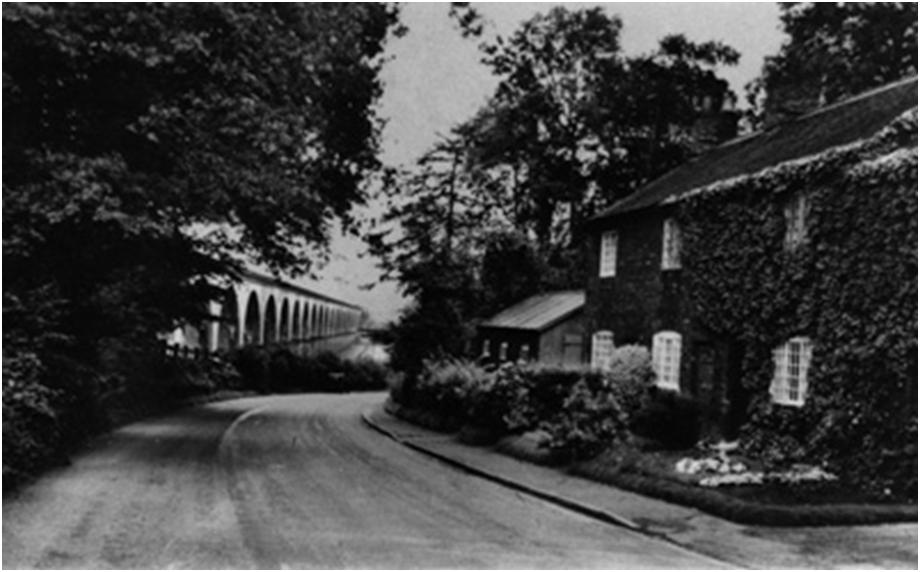
Holmes Chapel’s population easily doubled during the construction of the viaduct. In the census in 1831, the population was 406. During construction in 1841, it rose to 1008, and afterwards in 1851 it fell back to 555. Over 500 people were involved in the building of the viaduct – masons, bricklayers, carpenters and a vast number of “navvies” whose dress and outlook made them a distinct social class. There was no accommodation for such numbers in the village, and most lived in a camp adjacent to the viaduct. Because of demands on local bakers, sometimes navvies had to walk four miles to Middlewich for a loaf of bread.
The viaduct is the longest on the line at 1794 feet with 23 arches each of 63 feet span, a considerable feat of engineering for over 150 years ago. Stockport viaduct is higher, but is also slightly shorter.
This article was published in "The Villages Mag" February 2018
Click here to return to top of page.
The origins & early years of St Luke's Church Holmes Chapel
 |
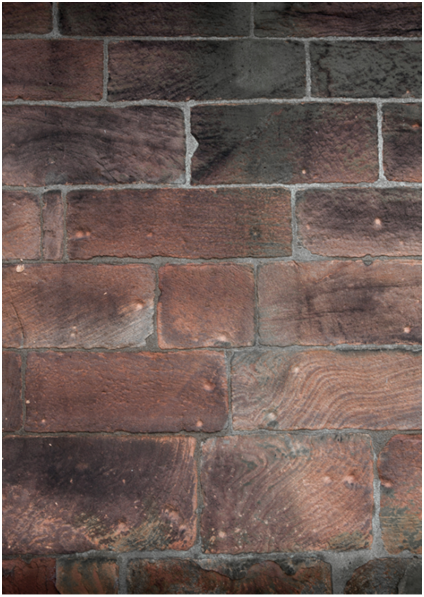 |
The early history of St Luke’s Church in Holmes
Chapel is not clear, but there is a possibility that the site where the
church now stands was a place of pagan worship before a church was
built. The earliest indication of there being a church is 1265 when the
abbot of Dieulacres Abbey near Leek gave permission to the abbot of
Chester for services to be held in the “Chappell at Church Hulme”. We
don’t know what that church looked like but as Holmes Chapel was even
then at a busy North-South and East-West cross roads perhaps we should
not be surprised that funding was provided for a new church in the
1430s. We believe this was donated by the Needham family who came from
Derbyshire and settled in Cranage. The church they built would have
been black and white timber framed building, a bit smaller than now but
with the tower and wonderful vaulted roof as we see to this day. The
church used to have tombs and stained glass in memory of the Needham
family but they have all vanished.
During the Civil War there was a skirmish between Royalist and
Parliamentary soldiers on 26th December 1643 and shots were fired from
approximately where Barclays Bank is now. Two men were killed. You can
see the musket ball marks on the tower to this day, which are strongly
believed to be as a result of the skirmish.
This article was published in "The Villages Mag" March 2018
Click here to return to
top of page.
Rudheath - a Wild & Lawless Sanctury
The Rudheath area of Allostock and Cranage including Woodlands Park, Shakerley Woods, BoundaryBarn and Rudheath Lodge was once a wild and lawless sanctuary for criminals.

In early mediaeval times Rudheath was one of three Cheshire sanctuaries provided for criminals under the powers granted to the Earls of Chester. Rudheath Sanctuary used to stretch from the edge of Northwich through Allostock and Cranage to Goostrey. In this extensive wood containing swamps and thickets fugitives were allowed to live provided they paid a fine to the Earl of Chester and fought for him when called on. These were difficult times. 1349 saw the onset of the Black Death and in 1353 there was an uprising against the Black Prince, Earl of Chester and his officials. Rudheath was notorious for outlawry, murders and violence. Eventually “in consequence of grievous clamour and complaints ---of many robberies and murders” an act of parliament was passed to prevent “outlawry” and impose “forfeiture of goods”. Even after this, areas of Allostock and Cranage bore a bad name as wild and lawless places.
In May 1644, Prince Rupert with 10,000 men camped on the great remaining spaces of Rudheath, Knutsford Heath and Bowdon Downs.
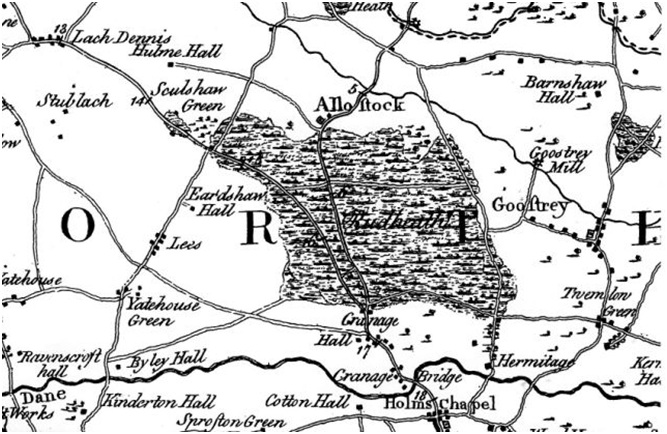
By 1777 Burdett’s map shows the Rudheath woodland in Allostock and Cranage had been much reduced by enclosures.
Alan Garner’s novel “Red Shift” is partly placed in the once lawless heathland waste in Allostock where Woodlands Park is today.
This article was published in "The Villages Mag" April 2018
Click here to return to top of page.Henry Cotton - Our Local Golfing Ledgend
Many people, even those not players of golf, will have heard of Henry Cotton. Who knew that this legendary golfer was born in Holmes Chapel?


Born on 26 January 1907 at ‘The Croft’, a large house on Macclesfield Road Holmes Chapel, now demolished. Henry’s father, George Cotton, owned the Victoria Works next door which produced Steam Hot Water Boilers. This is now the site of the wallpaper business. George, a widower, remarried in 1904 to Alice Le Poidevin and they had three children, including Henry, all born at The Croft. In December 1910, Henry then aged 4, the factory and house were sold and the Cotton family settled in South East London. Henry and his older brother later attended boarding school in Dulwich. Although a good cricketer Henry loved golf and turned professional in 1924, aged only 17. He was soon a golfing star winning the 1934, 1937 and 1948 Open Championships, the U.S. Open in 1956 and numerous other tournaments.
During World War II he served with the RAF and raised money for the Red Cross by playing exhibition matches. This earned him an MBE.
He retired from competitive golf in the early 1950s and became a successful architect of golf courses, wrote 10 books and established the Golf Foundation helping young boys and girls get started in golf. Henry Cotton loved the high life, champagne, caviar and bespoke tailored clothes and bought an estate complete with butler and full staff. He traveled everywhere in a Rolls-Royce He died in December 1989 in London.
This article was published in "The Villages Mag" May 2018
Click here to return to top of page.Heavy Industry at Cranage?
Cranage Forge was situated alongside the River Dane on the site of Massey’s Mill which was an ideal site for heavy industry in the 17th Century. Its location provided water power for the finery, the chafery and the slitting mill and access to woodland for charcoal. The Forge was well sited on the main north-south route between Lancashire and the Midlands for the movement of the finished products. The earliest record of the Forge is the 1660s with information concerning the purchase of wood for charcoal, which at that time was the main heating fuel.
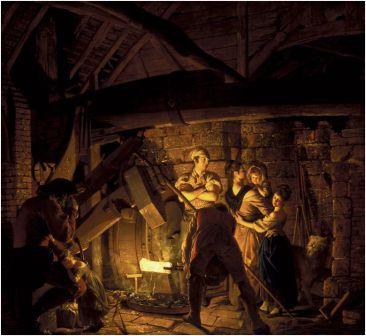
The main activity was the refining of pig-iron into wrought iron. The pig-iron came mainly from the furnaces at Church Lawton and Vale Royal. The first process was carried out in the finery, where the pig-iron was repeatedly heated in the hearth and hammered until the remaining carbon was beaten out. At the chafery hearth the hammer man would reheat the iron again to be drawn out into bars. Some of the bars would be worked through the slitting mill into rods for the nail making trade. Estimates of the amount of wrought iron produced at the Forge may have reached over 150 tons per year at peak times. By the 1750s the use of coke, rather than charcoal, in the smelting of iron and other factors brought to an end the iron industry at Cranage. The site continued as a mill utilising the water power for silk production and flour milling into the 19th century.
This article was published in "The Villages Mag" June 2018
Click here to return to top of page.The Great Fire of Holmes Chapel 1753
A report in the Manchester Mercury dated 17th July 1753 stated that on the “previous Tuesday (10th July 1753) a fire broke out in the house of a button-maker in Holmes Chapel. There was a high wind and in a few hours 15 out of the 19 houses in the town were reduced to ashes”.
The buildings which escaped the fire were the church, the Red Lion and the cottages behind the church with low roofs. The fire came very close to the Church. Lime trees which circled it, planted in 1743, were scorched but survived. They were removed in 1960 because they had become decrepit and dangerous.

At the time of the fire most of the inhabitants were at a monthly meeting in Northwich. As a result there appears to have been no loss of life. A consequence of the fire is that the oldest buildings in the village, except those mentioned, are late 18th/19th century.
There is no known record of how the fire was put out or what equipment was available at the time in Holmes Chapel. However fire engines were in existence in the country at the time.
The earliest references to an “engine” in Holmes Chapel is found 1866. However in 1892 some willows thought to have been behind the present Sainsbury’s and Costa caught fire “and in a few minutes about 50 dozen hampers and 50 tons of dry willows, together with the shed that contained them, were in one monstrous blaze”. It is stated that water was brought from pumps in buckets to bring the fire under control as it was no use getting the fire engine out because there was insufficient water to feed it.
This article was published in "The Villages Mag" August 2018
Click here to return to top of page.Holmes Chapel on Armistice Day 1918
In November 1918, Holmes Chapel village was at a low ebb. Not only had 28 members of the community died at the Front over the past four years (out of a population of 926 residents in 1911), but also Spanish flu had broken out a few weeks earlier. Both Cranage School & Macclesfield Road County School were closed because of the epidemic on Wednesday 16th October, and did not reopen until 18th November. Saltersford College was also seriously affected. Flu also impacted the Paper Works on Tuesday 15th October when 13 were compelled to cease work. A dance was cancelled on 25th October due to the epidemic, and four deaths were reported in the newspapers as being due to influenza between 27th October and 6th November.
On Monday 11th November, when news of the Armistice reached Holmes Chapel, the local mills ceased work, and employees were given a three day holiday. However, there were no holidays at the schools because they were already closed. The village centre was quickly dressed with an abundant display of flags and bunting, and peals were rung on the church bells until nearly midnight.
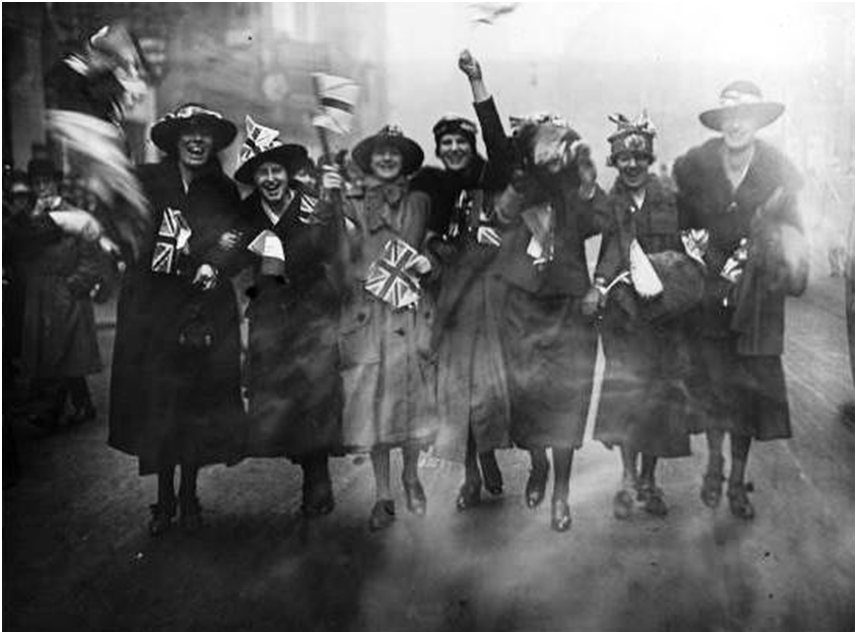
This article was published in "The Villages Mag" September/October 2018
Click here to return to top of page.The Bells of St Luke’s Church, Holmes Chapel
One of the pleasures of living in Holmes Chapel is hearing the bells of St Luke’s as they call worshippers to church and mark special occasions, both happy and sad. The bells have a long and interesting history.
There are seven in total, six of them dating back to the early years of the eighteenth century, though one was recast in 1858 and the original inscription replaced by the founder’s name: G. Mears of London. The seventh bell was cast by the same firm and bears the same date and inscription.
The smallest bell is dated 1706 and is known traditionally as
the Dagtail or Draggletail Bell. It would be rung hourly between 6am
and 6pm for the benefit of the workers in the fields, most of whom
would not possess a watch. Its name derives from its other use of
calling last minute stragglers to church services. The other five, and
maybe the Draggletail too, were given to the church by Daniel Cotton
(1660 – 1723), one of the family of ironmasters who owned Cranage Forge
and other ironworks in the area. All the bells were inscribed with
short phrases such as:
“I’le sally forth Queen Anns Great Worth. The gift of Daniel Cotton,
Ironmaster, 1709.”
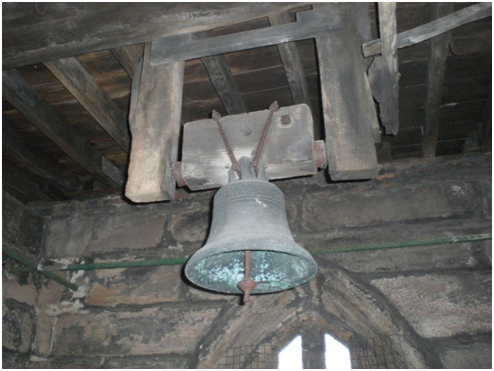 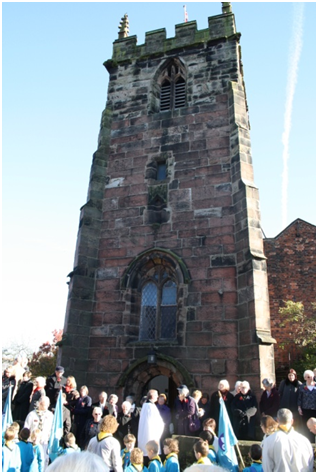 |
The religious and political disagreements which had led to the Glorious Revolution of 1688 had not diminished by the reign of Queen Anne (1702 – 1714). The French King Louis XIV sought to dominate Europe and restore the Catholic Stuarts to the English throne. Thus, with this quotation, Daniel Cotton was able to demonstrate his loyalty to the Crown and keep the villagers of Holmes Chapel informed of the great events of the time.
This article was published in "The Villages Mag" November 2018
Click here to return to top of page.
A Bit of Scandal - Agnes Needham
Agnes was a Needham, the family believed to have financed the re-building of St Luke’s Holmes Chapel in the 1400s. They had two estates, one at Cranage and the other at Shavington in Shropshire. Agnes was born at Shavington in 1547 but would have visited Cranage Hall.
She became the second wife of Sir Richard Bulkeley, Sheriff of Anglesey and Constable of Beaumaris Castle. They lived at Baron Hill in Anglesey. The house was rebuilt by Sir Richard’s son by a previous marriage, Richard (See photo below).
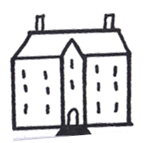 |
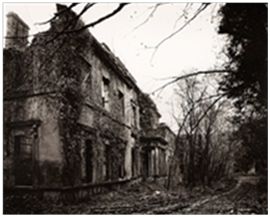 |
Agnes gave Sir Richard 2 sons,Launcelot (later Archbishop of Dublin), and Arthur. She and stepson, Richard did not get on. Once Agnes’s husband, Sir Richard had died after an illness, stepson Richard demanded his younger brother John marry a local heiress. However Agnes had arranged for Arthur to marry her. Next thing, Agnes is accused of murdering her husband. Poison is found in a chest in her room under some slippers. She is also accused of adultery with William Kendrick “a young gallant” who “did use to walk under her window in the night time, play upon an instrument and make love to her” when Sir Richard was away.
After a court case lasting 3 years Agnes was acquitted of murder but found guilty of adultery.
Having married again- to Lawrence Cranage of Keele, she lived the rest of her life and was buried (Jan 1622/3) in Holmes Chapel.
This article was published in "The Villages Mag" February 2019
Click here to return to top of page.Dr Lionel James Picton - The Village Doctor
For 45 years the inhabitants of Holmes Chapel and district were fortunate to have him as their doctor.
Born in 1874 at Bebington, Cheshire, he qualified at St. Bartholomew’s Hospital London in 1900 and came to Holmes Chapel in 1903. In 1904 he married Mary Emma Binney, a nursing sister. They later had six children. The Doctors surgery was at his home, Sadlers Close, off Knutsford Road. Mrs Picton worked with him, making the medicines.
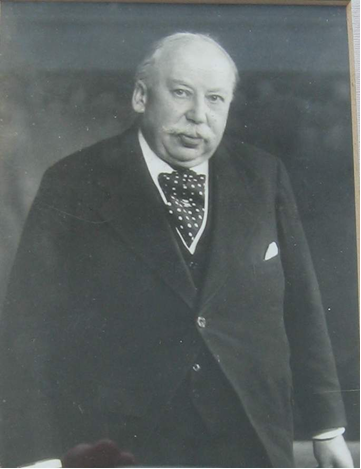
Dr. Picton was a familiar figure, wearing a cloak and a wide brimmed hat and riding his horse, his mode of transport until he got his first car - a de Dion Bouton. Highly respected, there are many reports, ‘Dr. Picton attends’, at whatever time of day or night.
He had strong views on nutrition and wrote a book ‘Thoughts on Feeding’ about the benefits of good nutrition, soils, grains, and he even developed a breed of cattle, which was eventually lost to Foot and Mouth disease. Woe-betide a household with white bread on the table when he visited, he just threw it away.
During the First World War Dr Picton spent time at a field hospital in Calais and was the Medical Officer for Somerford Hospital, which cared for wounded soldiers.
Doctor Picton was awarded the OBE in 1920. He died on November 19th 1948 at the age of 74. Some people today still remember him, as do others his son, Dr.Arthur Picton (Dr. Arthur), who followed him in the practice. Picton Square is named after Dr. Lionel.
This article was published in "The Villages Mag" March 2019
Click here to return to top of page.Morreys of Holmes Chapel
Now relocated to the trading estate on Manor Lane, the original site of this long-established business was in the village centre: it is now occupied by Costa and Sainsburys.

By 1850 Thomas Morrey was working as a cooper. He was followed by his sons: William carried on the barrel making and Arthur started a drapery, reputedly in the basement. What had been Forshaw’s gas showroom was absorbed into Morreys, becoming the paint shop. Apart from paint, here you could buy paraffin for the domestic heater. It was pumped from a can kept at the back of the shop. At the north end, what had been Plant’s saddlery became the gentleman’s outfitter department of Morreys, run by Len Tallon. Len neatly wrapped every purchase into a brown paper parcel tied with string. In the era of David Morrey the upstairs gradually became the bike showroom and the top storey was used as a store. The stock of electric lamps, being light weight, was kept at the furthest extremity deep into the attic, through a series of small rooms. There was an office at the back of the shop where Mrs Thomas calculated the wages on her hand cranked calculator. Behind this was a bike repair shop. In the 1950s Morreys had a branch in Middlewich, run at one time by Albert Rathbone. There it was possible to buy a small amount of paint tipped out of a full can!
Morreys is the oldest surviving family business in the village and from 1850 until the move to Manor Lane was always partly staffed by members of the family.
This article was published in "The Villages Mag" April 2019
Click here to return to top of page.
Jodrell Bank Radio Telescope
The story of the Jodrell Bank Radio Telescope began in 1945 when, after wartime service researching radar, Bernard Lovell came back to the University of Manchester to observe cosmic rays. A quiet observing site was needed and the University’s botanical station at a little-known place called Jodrell Bank, 20 miles south of Manchester, proved to be the ideal location.
Bernard Lovell worked with engineer Charles Husband, to build the 76-metre telescope. Initially named the MK 1 Radio Telescope, it was renamed the Lovell Telescope on its 30th anniversary in l987. It became an icon of British science and engineering and a landmark in the Cheshire countryside.
The telescope was the world’s largest when completed in 1957 and within days tracked the rocket that carried Sputnik 1 into orbit, marking the dawn of the space age. It is still the third largest steerable telescope in the world and many upgrades mean it is now more capable than ever, observing phenomena undreamt of when it was first conceived.

In 2017 the Lovell Telescope celebrated its 60th anniversary and has been selected as the next UK candidate to go forward for nomination to UNESCO as a World Heritage Site. Other notable sites across the world include the Grand Canyon in the United States and Machu Picchu in Peru. Many of the structures at Jodrell Bank are protected by Historic England in recognition of their importance in the history of astrophysics. Still owned by the University of Manchester, the site includes the Jodrell Bank Observatory and a thriving Discovery Centre.
Over the years it has provided employment for many local families, both in the research department and the visitor centre, who all enjoyed the pleasant surroundings of the Cheshire countryside.
This article was published in "The Villages Mag" May 2019
Subsequently, in July 2019, Jodrell Bank was made a Unesco World Heritage Site.
Click here to return to top of page.
The Good Companions Cheshire's New Hotel Deluxe
The following is based on an article in the Crewe Chronicle on 25th March 1939. “The Good Companions” was opened by the famous actress Jessie Matthews who starred in the 1933 film "The Good Companions", based on the novel by J.B.Priestley:
“On Tuesday 14th March 1939, the Bull’s Head, owned by Wilson’s Brewery, closed its doors as a licensed house, and transferred the licence to the new hotel which opened on the following day. It is an imposing building, set back from one of the busiest main roads in the country, luxuriously furnishedwith nothing omitted for the comfort and enjoyment of patrons."


"On the ground floor there are a small bar; splendidly furnished smoke rooms and lounges; an attractive dining room with high-backed chairs; and a large room for meetings. The several bedrooms have hot and cold water laid on, and also upstairs is a spacious dance room. There is an orchestra whose playing is relayed to the various rooms by speakers which are cleverly hidden in ventilators which are covered with mural decorations depicting scenes from the book. There are similar scenes on the frosted glass doors and beneath the banister rail of the main staircase. At the rear of the building, facing tennis courts and a bowling green with pavilion, is a loggia with creepers and a tea garden where there will be open-air dancing in the summer. Hundreds of shrubs have been planted around the grounds.”
The hotel was a popular “road house” but lost business once the M6 by-passed the A50. It closed in 1992 and was later demolished.
Lovell Court now occupies the site.
This article was published in "The Villages Mag" June 2019
Click here to return to top of page.
The Benger's Factory
Some people are probably unaware of the nutritious food supplement known as Benger’s, which at one time was regarded as essential in the care of young children, expectant mothers and invalids, and of the fact that it was manufactured in Holmes Chapel in a state of the art building on London Road near the railway bridge. At its peak Benger’s was the major employer in Holmes Chapel and played an important role in the day to day life of the village. Its sports and social club was well attended and frequently used as a venue for local events.
Benger’s Foods, originally Mottershead and Company of Manchester, was acquired in 1870 by Frederick Baden Benger and Standen Paine, both pharmacists. It was renamed as Benger’s Food Ltd in 1903 and in 1938 was relocated to purpose built premises in Holmes Chapel. The Head Office, in an “ imposing but restrained” Art Deco style, and the factory were designed by the architectural practice of J H Andrews and Butterworth, Manchester, which specialised in the design of industrial buildings.
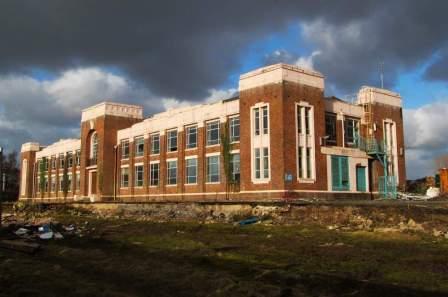 The Benger House building
was a fine example of the new "daylight factory" introduced into this
country during the 1920s. The aim was to make the workplace more
efficient and more pleasant for the labour force. Among the impressive
features was a domed lantern in pink and blue glass which lit the
staircase in the entrance hall and the glazed wall and floor tiles of
the manufacturing areas. In 1947 there were 350 employees and Bengers
Food was bought out by Fisons Ltd. Their pharmaceutical division based
in Holmes Chapel with its portfolio of asthma and anti-allergy drugs
was by far the most profitable of the company.
The Benger House building
was a fine example of the new "daylight factory" introduced into this
country during the 1920s. The aim was to make the workplace more
efficient and more pleasant for the labour force. Among the impressive
features was a domed lantern in pink and blue glass which lit the
staircase in the entrance hall and the glazed wall and floor tiles of
the manufacturing areas. In 1947 there were 350 employees and Bengers
Food was bought out by Fisons Ltd. Their pharmaceutical division based
in Holmes Chapel with its portfolio of asthma and anti-allergy drugs
was by far the most profitable of the company.  The Fisons group was dissolved in 1996 and the site and buildings were
acquired first by Rhone-Poulenc and then by Sanofi Aventis, who built a
brand new factory. The former Benger House was not included in the
redevelopment plan and it sat empty with little to show of its former
usage. It was a sad sight to see the once lovely building fall victim
to the ravages of time and the encroachment of nature. An application
to assess the building for listed status was received by English
Heritage in 2011 but was turned down because,
The Fisons group was dissolved in 1996 and the site and buildings were
acquired first by Rhone-Poulenc and then by Sanofi Aventis, who built a
brand new factory. The former Benger House was not included in the
redevelopment plan and it sat empty with little to show of its former
usage. It was a sad sight to see the once lovely building fall victim
to the ravages of time and the encroachment of nature. An application
to assess the building for listed status was received by English
Heritage in 2011 but was turned down because,
"While the frontage of Benger House has characteristic late Art Deco
features it does not exhibit sufficient interest or intactness
associated with the Art Deco style though it is clearly of strong local
interest."
It is thought that the location of the building in the then small
Cheshire village of Holmes Chapel may have modified any greater
flamboyance in the design.
The building was finally demolished in August 2015 and the site is now for sale for redevelopment.
This article was published in "The Villages Mag" July 2019
Click here to return to top of page.
The Jackson Family and the Wallpaper Works
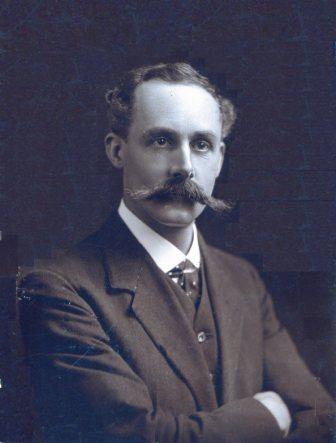 The wallpaper works on
Macclesfield Road (now FADs) has been operating in Holmes Chapel since
1911 when George Fenton Jackson took over the site with his colleague
James Walker. Both had been employed in the wallpaper business in North
Manchester and appear to have decided to establish their own business
in Holmes Chapel. George’s father, also called George, was a skilled
engraver so it was not surprising his son was described as a gifted and
talented wallpaper designer. Where his ambition to open his own
business came from is unknown.
The wallpaper works on
Macclesfield Road (now FADs) has been operating in Holmes Chapel since
1911 when George Fenton Jackson took over the site with his colleague
James Walker. Both had been employed in the wallpaper business in North
Manchester and appear to have decided to establish their own business
in Holmes Chapel. George’s father, also called George, was a skilled
engraver so it was not surprising his son was described as a gifted and
talented wallpaper designer. Where his ambition to open his own
business came from is unknown.
The factory site on Macclesfield Road had originally been a horticultural builders works where iron framed greenhouses were produced. Henry Cotton, who later became the world famous golfer, lived in a house on the site when he was a child.
The site was purchased in 1911 for the sum of £2600 by George Jackson and James Walker and they set up the Holmes Chapel Wallpaper Company. James Walker seems to have moved on and the business in Holmes Chapel was run by the Jackson family for three generations.

Apart from providing employment they had a major impact on the appearance and social activities of the village. It was Alfred Jackson, George’s son, who built the houses along Victoria Avenue and London Road and provided the Victoria Club as a social venue for staff and the community. Alfred also built several other houses in Holmes Chapel and as his daughter in law Dorothy Jackson said, ‘He liked to live life to the full and was always on the lookout for a trip or a project’. Alfred was very much involved in the community: he was a JP and Chair of Congleton Borough Council in the 1930s. George Fenton was also a serial house builder: two houses on Chester Road and ‘Twemlow Edge’ overlooking the River Dane from the Twemlow side were built by him.
In the next generation Sidney Jackson, son of Alfred, was a keen sportsman. He volunteered for the Royal Navy at the outbreak of the Second World War, was wounded at Dunkirk, took part in the Arctic convoys and learnt to play tennis in Alexandria. He settled into a house in Station Road and lived there until he died in 2002. His wife Dorothy was very involved in the community as a JP and Chairman of the Parish Council on several occasions. Some of the family, although not involved in the wallpaper works, still live in the village and continue to play a part in community activities.
This article was published in "The Villages Mag" September 2019
Click here to return to top of page.
The 1941 Holmes Chapel Rail Crash
At about 1:20 am on Sunday 14th September 1941, a serious rail crash occurred at Holmes Chapel Station when nine people were killed, six in the accident and three more died later. Forty five passengers were injured, with 21 being detained in hospital. The accident involved a Crewe – Leeds Express, a mail train, which was almost stationary in the station, and a Crewe – Manchester train, which ran into the rear destroying the last two passenger coaches of the Leeds Express.
 As the trapped passengers
struggled in the darkness, airmen and soldiers from the undamaged
coaches on both trains went to the rescue. Prompt measures were taken
by the resident Station Master and his staff who were awakened by the
crash, and by the Sergeant in charge of the Police Station, who
summoned medical assistance and ambulances, and initially attended to
the injured. Doctor Picton arrived at 1:40 am, and the first ambulance
arrived at about 2 am.
As the trapped passengers
struggled in the darkness, airmen and soldiers from the undamaged
coaches on both trains went to the rescue. Prompt measures were taken
by the resident Station Master and his staff who were awakened by the
crash, and by the Sergeant in charge of the Police Station, who
summoned medical assistance and ambulances, and initially attended to
the injured. Doctor Picton arrived at 1:40 am, and the first ambulance
arrived at about 2 am.
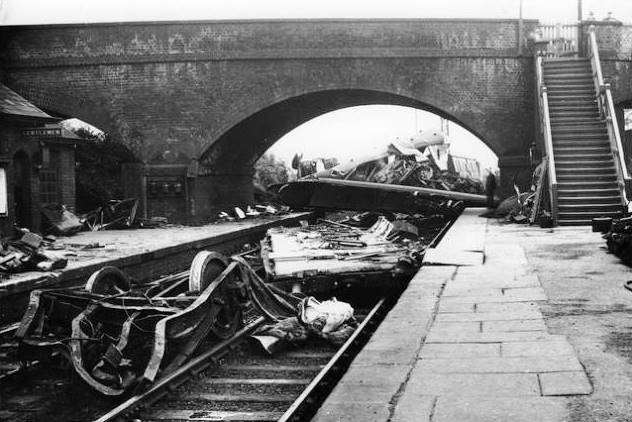 Villagers awoken by the
sound of the crash ran to the station with blankets and supplies of hot
water. Home Guards and local ARP workers joined the rescue gangs. The
Swan Inn was converted into a temporary dressing station where the
injured received attention before being taken to Arclid Hospital in
ambulances summoned from all parts of Cheshire. All the seriously
injured had been removed to the hospital by 3:15 am.
Villagers awoken by the
sound of the crash ran to the station with blankets and supplies of hot
water. Home Guards and local ARP workers joined the rescue gangs. The
Swan Inn was converted into a temporary dressing station where the
injured received attention before being taken to Arclid Hospital in
ambulances summoned from all parts of Cheshire. All the seriously
injured had been removed to the hospital by 3:15 am.
The dead were recorded as:
* Pilot Officer William Evans (25), of Newport, Monmouthshire
* Private Claude Lowder (22) of Spring Grove, Fenay Bridge,
Huddersfield, Yorkshire
* Sergeant John McCrae (31), RAF, of Park Avenue, Skipton, Yorkshire
* Private John Lennox (24), OCTU, of Jersey Avenue, Stanmore, Middlesex
* First-class Aircraftman Jeffrey Williams (23), of Hull
* George Christie Lowe (39) of Eden Street, Oswestry
* Reginald Gregory (35), Railway Guard, of Llanfair, Pear Tree Lane,
Wednesfield
* Stoker J Foster (26) RN, of Grimsby
* Eileen Ann Pritchard (13 months old) of Derby Terrace, Wrexham who
was travelling with her mother, who was seriously injured.
After an Inquest held at the Victoria Club, and a formal Inquiry at the Crewe Arms in Crewe, it was deemed that the crash was due to a number of factors, including old signalling technology that had been due to be replaced and the demands placed on signalmen working single handed on 12 hour night shifts 6 days per week. Of course, another important factor which was not mentioned at the Inquiry was that the crash occurred during the Second World War, in the middle of the night, when a complete blackout was in operation.
This article was published in "The Villages Mag" October 2019
Click here to return to top of page.
A Grave Spelling Mistake
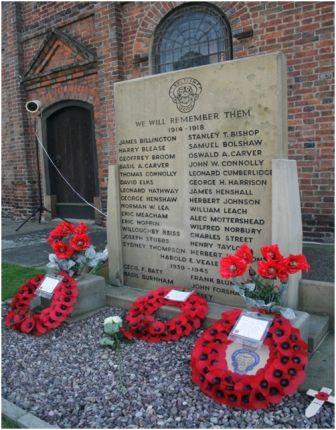 Well
more a WW1 Memorial spelling mistake – because we now believe Eric
Meacham (with a ‘C’), recorded on the Holmes Chapel Memorial was in
fact Eric Measham (with an ‘S’). It is quite surprising that this
error, visible for so long, has gone unnoticed but a number of factors
contributed. Firstly the memorial at St Luke’s church was not created
until after WW2 so it appears the name was copied from the Roll of
Honour in the church where the original error seems to have been made.
Well
more a WW1 Memorial spelling mistake – because we now believe Eric
Meacham (with a ‘C’), recorded on the Holmes Chapel Memorial was in
fact Eric Measham (with an ‘S’). It is quite surprising that this
error, visible for so long, has gone unnoticed but a number of factors
contributed. Firstly the memorial at St Luke’s church was not created
until after WW2 so it appears the name was copied from the Roll of
Honour in the church where the original error seems to have been made.
We know an Eric Measham existed along with brothers Harry, Fred and George from census records. Those three brothers are also mentioned on the Roll of Honour with the same spelling mistake! From his military records we know he lived at the Cranage Club, now Cranage Village Hall, for a while where he was probably working for the Carver family at Cranage Hall.
The Parish magazine of March 1917 states ‘E. Meesham is officially reported missing’ and in July 1917, ‘Eric Measham missing since last July has been officially reported dead.’ There is clearly confusion over the spelling of his name at the time and it appears that the wrong option was selected when the memorial was constructed.
It is probable that the family moved away shortly after the end of WW1 and so, sadly, were not around to point out the error.
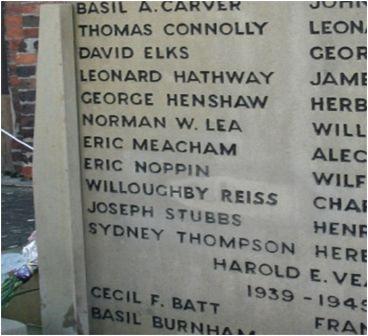 |
 |
Eric Measham has no war grave but he is recorded (correctly spelt) on the Thiepval Memorial in France.
This article was published in "The Villages Mag" November 2019
Click here to return to top of page.
Cranage Hall
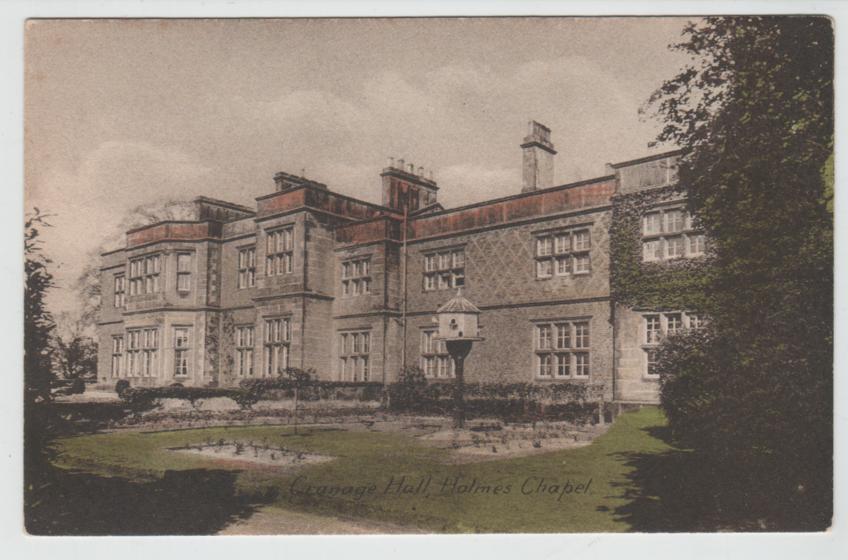
The manor of Cranage was mentioned in the Domesday Survey of 1086 and it is possible that a hall was built there not long afterwards. By the seventeenth century a “brick mansion house” occupied the site, though this was demolished when the present building was erected in 1829. For centuries the Hall was the centre of a large agricultural estate and the home of a series of wealthy families, most notably the Needhams, who acquired the property by marriage to the heiress Alice Cranach. In 1625 Sir Robert Needham was created Viscount Kilmorey, though by then the main branch of the family had moved to Shropshire and other relatives occupied the Hall. It was sold in 1660 to William Swettenham and sold again in 1679 to the Reverend William Harrison, who was the son of a Tatton farmer. Most of the land remained in the ownership of the Needhams until 1760, when the manor was sold to Thomas Bayley Hall of the Hermitage. Several generations of Harrisons lived at Cranage Hall until it was sold to the Reverend John Armitstead, vicar of Goostrey, in 1814. In 1828 his son Lawrence bought the neighbouring Hermitage Estate and commissioned Lewis Wyatt to build the fine new house at Cranage where he lived until his death in 1874. A cousin, the Reverend John Richard Armitstead, Vicar of Sandbach, inherited and occupied the Hall from 1877 to 1918. His son, the Reverend John Hornby Armitstead, Vicar of Holmes Chapel from 1899 to 1918, was the last Armitstead to live there. In 1900 the Hall was leased to William Oswald Carver, owner of a cotton mill in Marple, who purchased the estate in 1920. By 1927, having lost two of his sons in the First World War, he decided to downsize, moved to Hartford Hall, and put Cranage up for auction. Its days as a family home were over.
It was not until 1929 that the Hall and grounds were acquired by the local health board for use as a mental hospital. The Hall housed the offices and the Cranage Colony, a small village in its own right, was built in the grounds. This included residential villas, a social hall, swimming pool, shop, cafe and maintenance buildings. The Colony employed many local people and its closure in 1995 shocked the community. The Hall fared particularly badly in the three years it lay empty, with thieves taking all the oak panelling, doors, floorboards, fireplaces and even the main staircase! Thankfully, it was purchased by a hotel group and comprehensively renovated, retaining its status as a Grade 2 listed building. Today it is the DeVere Cranage Estate Hotel and conference centre.
This article was published in "The Villages Mag" December 2019
Click here to return to top of page.
Holmes Chapel Before the M6
The Staffordshire to Preston section of the M6 through Cheshire opened in November 1963. Before then London Rd, the A50, was the main north route to Scotland west of the Pennines. This meant that all the trunk road traffic had to pass through Holmes Chapel and squeeze past the church. It was great entertainment for the children, on hearing a heavy load coming through the village, to dash towards the Square to watch the load being inched around the church. The building now occupied by Latham Estates has scars in the brickwork as evidence of these struggles. In those years, if the firemen were needed for an emergency call, the siren would sound out 'long and loud'. This also alerted the children to dash into the village, this time to catch the fire engine as it turned into London Rd with its bell clanging.
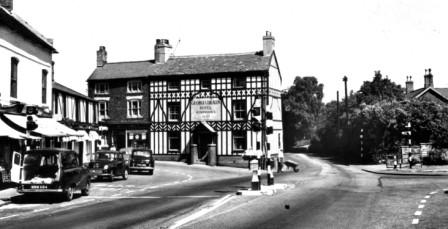
The village, pre M6, was of a 'cosy size'. There was the original village centre with ribbon development along the main roads and, from about 1950 onwards, there were three areas of council housing:- Rees Crescent, Northway and Westway. Most of the young children in the village at that time attended the County Primary School on Macclesfield Rd, now the Catholic Church. Those living west of the A50 had to be shepherded across the centre of the village at the traffic lights by the 'lollipop lady'. For many years this service was provided morning and afternoon by Mrs Buckley. On their way to school the children could stop to buy sweets either at Mrs Warburton's, 'up the steps' next to the Co-op, or at Mrs Dale's on Macclesfield Rd. We weren't so careful of our teeth in those days. For those on the 'wrong side' of the village getting to Sunday School could be a challenge in the autumn. This was the season of 'Blackpool Lights' and the way across the road into church would be blocked by coaches heading for Blackpool queuing at the traffic lights.
The 1950s were the years of the 11 plus exam so, after being together through their primary years, the children would leave Holmes Chapel in many different directions on their way to senior school each morning - to Middlewich, to Sandbach for the Boys Grammar and to Crewe for the Girls’ Grammar School. After 1957, when a new grammar school opened in Congleton, most of the girls from Holmes Chapel went there. Some children had to cross London Rd to catch the school bus without the help of the 'lollipop lady'. The coach for Congleton picked up the girls on Station Rd so for girls living west of the A 50 this might mean negotiating first, Chester Road, which didn't have a footpath, and then the lorries on the A50 at the junction between Chester Rd and Station Rd. This was always a challenge even when the traffic was stationary right through the village which often happened. The M6 relieved some of these difficulties.
This article was published in "The Villages Mag" February 2020
Click here to return to top of page.
The College of Agriculture & Horticulture
Holmes Chapel was the original home of the Cheshire College of Agriculture, situated at Saltersford Hall on the site of Saltersford Bungalow at Saltersford Corner. It comprised of a 100 acre of farm and gardens and was established in 1895 to fulfill the need for agricultural and horticulture education in Cheshire. There was accommodation for 60 residential students who mainly came from the county.
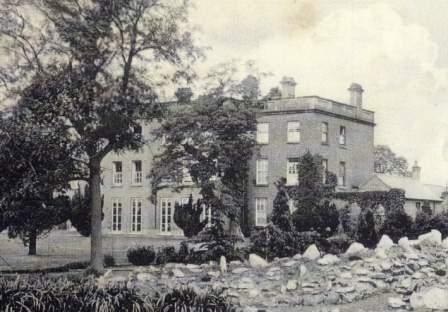
Whilst the emphasis was on scientific and technical subjects it also gave tuition in all aspects of practical farming. Research work was also undertaken, both in the laboratory and on the land. The Horticultural Division was the only establishment of its kind in the country at that time. Two year courses were held in the sciences of farming and culminated with the students sitting the exams of the Royal Agricultural Society. Later, in conjunction with Manchester University, B.Sc degrees in agriculture were awarded. Farmers and private individuals used the advisory service provided. The College would report on anything from milk for its acid content, seed germination, grasses for permanent pasture and analysis of manure and fertilisers etc. The original Principal was James Scott Gordon. Later Mr T.J Young held the position and continued to do so throughout the College’s existence at Holmes Chapel.
By 1914 the college was well established and highly respected both in the county and nationall with 56 students, their ages averaging 16 to 20 years. At the outbreak of World War I, eligible students enlisted in the services. Consequently a large reduction in students interfered with the running of the College, a difficulty which continued throughout the War.
In 1916 the War Office agreed with the Board of Agriculture that suitable disabled soldiers and sailors could attend the college for training in agriculture and horticulture. However, once this agreement finished, it was decided the College was to be closed by the end of March 1917 as it could no longer justify the funding with the shortage of students. A reprieve came with the formation of the Women’s Land Army in 1917 and training courses for them were carried out at the College from May to October of that year. In January 1918 the Home Office applied to the County Council for the College to be used as a temporary annexe to the Bradwall Training School for young offenders, which was granted. The Training School took over the lease in 1919 and was fully established at Saltersford until it, too, was closed in 1954. Although for a time it was intended to reopen the Agricultural College at Saltersford Hall after the War, this never happened. Instead, it transferred to Reaseheath near Nantwich where it is today. The Training School took over the lease in 1919 and was fully established at Saltersford until 1954 when it, too, closed.
This article was published in "The Villages Mag" March 2020
Click here to return to top of page.
What's In a Loaf?
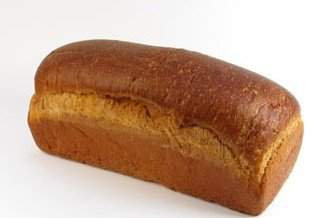 During the 1930s Dr. Lionel Picton, who had been
the Holmes Chapel GP since 1903 and who was the subject of an earlier
feature in this magazine, devised a recipe for a wholemeal loaf which
became known as Fertility Bread. Dr. Picton was an advocate of healthy
eating and good nourishment. He strongly believed that a woman’s good
health was essential for fertility and the nurturing of a healthy baby.
An intended aid towards this was a wholemeal loaf made from locally
grown and ground wheat, mixed with half its weight in raw wheatgerm.
During the 1930s Dr. Lionel Picton, who had been
the Holmes Chapel GP since 1903 and who was the subject of an earlier
feature in this magazine, devised a recipe for a wholemeal loaf which
became known as Fertility Bread. Dr. Picton was an advocate of healthy
eating and good nourishment. He strongly believed that a woman’s good
health was essential for fertility and the nurturing of a healthy baby.
An intended aid towards this was a wholemeal loaf made from locally
grown and ground wheat, mixed with half its weight in raw wheatgerm. 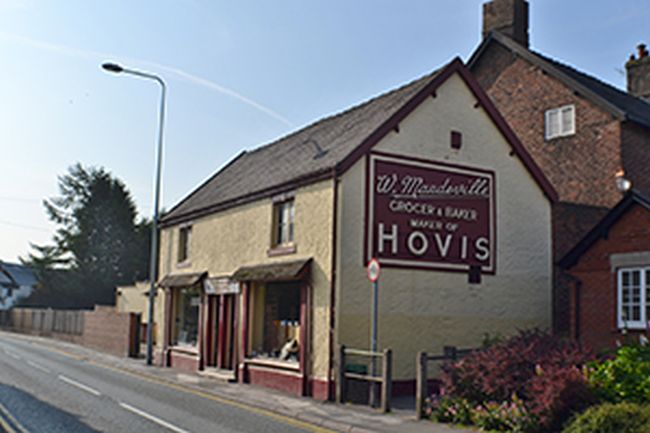 Dr
Picton believed that Vitamin E, found in wheatgerm, was an essential
aid to fertility. Moreover, the ingredients had to be absolutely fresh
and baked within 48 hours as the potency of the Vitamin E would
diminish. The resulting loaf was both nutritious and tasty. A patent
was obtained by William Mandeville and production began at his bakery
on Macclesfield Road, Holmes Chapel.
Dr
Picton believed that Vitamin E, found in wheatgerm, was an essential
aid to fertility. Moreover, the ingredients had to be absolutely fresh
and baked within 48 hours as the potency of the Vitamin E would
diminish. The resulting loaf was both nutritious and tasty. A patent
was obtained by William Mandeville and production began at his bakery
on Macclesfield Road, Holmes Chapel.  The
wheat germ came fresh off the rollers of a Liverpool mill and the fame
of the loaf soon spread. Loaves were sent far and wide by post and the
bakery received letters asking for advice from all over the world!
However, its popularity was short lived. Production ceased with the
commencement of the Second World War as the Ministry of Food cut short
supplies of the wheatgerm as a war measure and post war production
proved impracticable. Unfortunately there are no figures available as
to an increase in the population attributable to the bread.
The
wheat germ came fresh off the rollers of a Liverpool mill and the fame
of the loaf soon spread. Loaves were sent far and wide by post and the
bakery received letters asking for advice from all over the world!
However, its popularity was short lived. Production ceased with the
commencement of the Second World War as the Ministry of Food cut short
supplies of the wheatgerm as a war measure and post war production
proved impracticable. Unfortunately there are no figures available as
to an increase in the population attributable to the bread.
This article was published in "The Villages Mag" April 2020
Click here to return to top of page.
Holmes Chapel on VE Day 1945
The Second World War had been going on for six years since 1939 and the world had changed even for people in the relatively remote village of Holmes Chapel. Many men and women had joined the services and left the area. However, unlike the First World War the community at home was very much involved in the war machine.
The wallpaper factory was now producing munitions which were stored at a Royal Army Ordnance Corps depot along Manor Lane. There was an airfield at Cranage from which flying missions attacking enemy aircraft took place. In Byley there was a factory where Wellington Bombers were built. Troops had been billeted in the village; evacuees were living with families; American servicemen had stayed at The Hermitage and Sandiford Cottage; Italian and German POWs had stayed at the Bull and Sandiford Cottage; and people were subject to rationing, growing their own food. Even grass verges were ploughed up to "Dig for Victory".
And then on May 7th 1945 reports came through on the wireless that the war in Europe was over and VE Day was declared for Tuesday May 8th. Not many people are now alive who can remember that day in Holmes Chapel but we have learnt that it was a day of spontaneous celebration centred on the Good Companions Hotel which was on the site of Lovell Court in the centre of the village. This was a brand new hotel only opened just before the war and had a large car park at the front. This became the location for drinking and dancing well into the night. A band played on a flat bed trailer which had been brought along.
There are reports of flags displayed around the village but sadly no photographs have been found to confirm this. No doubt it was more important to celebrate than take photographs.
Following a day of celebration, apart from thanksgiving services and peals of bells, it appears life went back to normal and people gradually adjusted to peace time although rationing continued and in fact became more severe in the years to come. This may have influenced the Parish Council who decided not to support the Victory Celebrations planned for June 1946 proposed by the government. Clearly for the village of Holmes Chapel one day of celebration was enough.
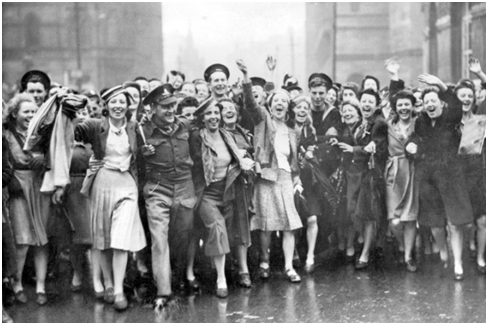
We would love to have included a photo of Holmes Chapel celebrating and maybe you have one in your album you could let us see. This photo at least illustrates the general mood on the day.
This article was published in "The Villages Mag" May 2020
Click here to return to top of page.
Cranage Airfield
The recent commemoration of the 75th anniversary of VE day revived memories locally of the wartime airfield at Cranage. Many readers will want to know more about RAF Cranage and its role in the defence of the nation.
The site of Cranage Airfield was chosen for use as a training and maintenance unit in August 1939. Originally just a grass airfield with three runways, these were upgraded with Army Track Wire Mesh then replaced with American Metal Planking in April 1943. It had 8 blister hangars for maintenance use. At Byley, close to the airfield, was a Vickers Armstrong factory assembling Wellington bombers. The completed aircraft would be towed from the factory to the airfield for their first test flight and then onward for delivery.
Several flying units were based at the airfield. The first was No 2 School of Navigation formed on October 21st 1940. It operated twin engine Avro Ansons for training navigators. In 1942 it was renamed the Central Navigation School and was increased to 58 Ansons. From December 1940 the airfield also housed its first operational squadron. 96 Squadron was equipped with Hawker Hurricanes and operated in the night air defence role. It mainly protected the industrial and port areas of Liverpool. Then, in July 1941, 1531 Flight was formed as a Beam Approach Training Flight using the Airspeed Oxford. When the Central Navigation School was moved out to RAF Shawbury, Cranage became the home of the Repair and Inspection Squadron of Servicing Wing.
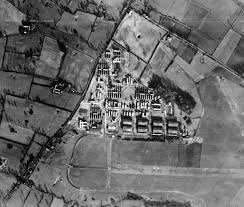 In 1944 the USA Army Air
Force 14th Liaison squadron worked from the site operating Sentinels.
This unit was part of the 9th Air Force and General George Patton’s 3rd
Army. Patton himself visited Cranage Airfield in May 1944 from his
nearby headquarters at Peover Hall where he was staying while he
prepared for Operation Overlord and the Normandy landings. As the war
drew to a close flying at Cranage was reduced. A detachment of No 12
Pilot Advanced Flying Unit operated there from February 1945. The only
flying unit operating from the airfield after the war was No 190
Gliding School which was formed in May 1945 using Kirby Cadet gliders.
It operated from the site for two years.
In 1944 the USA Army Air
Force 14th Liaison squadron worked from the site operating Sentinels.
This unit was part of the 9th Air Force and General George Patton’s 3rd
Army. Patton himself visited Cranage Airfield in May 1944 from his
nearby headquarters at Peover Hall where he was staying while he
prepared for Operation Overlord and the Normandy landings. As the war
drew to a close flying at Cranage was reduced. A detachment of No 12
Pilot Advanced Flying Unit operated there from February 1945. The only
flying unit operating from the airfield after the war was No 190
Gliding School which was formed in May 1945 using Kirby Cadet gliders.
It operated from the site for two years.
Cranage Airfield did suffer casualties, aircraft crashed on take off and landing and during test flights after aircraft had been assembled or repaired. The war graves of 16 aircrew can be found in the churchyard of St John, Byley. These include 13 from the UK, 2 Australians, 2 Canadians and 1 from New Zealand. Their ages range from 19 to 31, they made the ultimate sacrifice in defence of this nation.
Flying ceased from the site in 1947 but was used for storage
and maintenance. In 1954 the airfield was allocated to the USAF as a
satellite for their site at RAF Burtonwood. It was home to a detachment
of 7493 Special Investigation Wing and 7523 Support Squadron and a
number of their non flying units were also stationed there. At the end
of June 1957 the USAF returned the base to the RAF and it was closed
permanently in 1958 with the hangars being dismantled and sold. Remains
of part of the airfield defences of RAF Cranage survive well, including
some of the battle headquarters, a gun pit, three 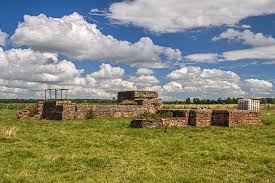 pillboxes and a night accommodation aircrew sleeping shelter. These are
rare survivals nationally and they illustrate well some of the measures
taken to protect airfields from the threat of capture. These airfield
defences were constructed in two phases. In the 1930s they were
designed to provide protection from air attacks but in the spring of
1940 it was realised that airfields could be targets in a strategy
aimed at capturing them and so pillboxes and battle headquarters were
added. Historic England listed the airfield remains as a Scheduled
Monument in July 24th 2002.
pillboxes and a night accommodation aircrew sleeping shelter. These are
rare survivals nationally and they illustrate well some of the measures
taken to protect airfields from the threat of capture. These airfield
defences were constructed in two phases. In the 1930s they were
designed to provide protection from air attacks but in the spring of
1940 it was realised that airfields could be targets in a strategy
aimed at capturing them and so pillboxes and battle headquarters were
added. Historic England listed the airfield remains as a Scheduled
Monument in July 24th 2002.
This article was published in "The Villages Mag" June 2020
Click here to return to top of page.Holmes Chapel's Water Supply
In the 19th century the village had no mains water. People had to rely on private groundwater wells, rainwater collected and stored in tanks (as at The Hollies) and natural springs. There were at least three of these :- one half way down the bank out of the village on Knutsford Rd known as The Spout, Nicker’s (or Nicho’s) well half way down the bank leading to The Hermitage (closed in 1934) and a well on London Road near Victoria Avenue (closed in 1916). In 1909 a scheme was put forward to supply piped water to Holmes Chapel. Mr Wyatt the engineer estimated the cost to be £1,950. Fourteen tenders were received and a tender for £772 from Stanton Iron Co was accepted. This tender was perhaps for the supply of pipes only because by 1910 Holmes Chapel was borrowing £1631 for the laying of water mains to the village. The water was brought from Delamere through Middlewich, with a booster pump at Sproston. This supply proved to be inadequate and properties beyond the village boundary such as Cranage Hall could not be supplied.
By 1915 complaints were being made via the clerk of Congleton Council to be passed on to Middlewich Urban District Council. The water pressure at Middlewich was 50lbs but Holmes Chapel was only receiving 8-10 lbs such that sometimes the farmers could not get ‘enough water to cool the milk’. There is a height difference of thirty metres between Holmes Chapel and Middlewich and the problem was thought to be one of pumping and not rainfall. The shortage was eventually solved by turning off a valve to restrict the supply to Middlewich. In May 1916 the water was turned off for a whole day without warning and the people of Holmes Chapel complained that they had had to ‘go back to the old times and take their cans and buckets to the pump’. Mr S Moss was put in charge of the mains in 1917 and was responsible for flushing the system once a month. In 1926 he reported that water was being wasted and a leaflet was sent to all householders urging them to limit their consumption, which was much lower than we would regard as acceptable today. By the 1930s attempts were being made to improve the supply throughout mid Cheshire but progress was slow. Only in 1945 were local newspapers able to report that the Northwich and Congleton water project was complete. The new seven inch water main now ran from the reservoir at Heyeswood near Hartford to the boundary of Congleton passing through Allostock, Byley, Holmes Chapel and Goostrey. Dignitaries made a tour of the trunk and finished at the Good Companions in Holmes Chapel where they were hosted by the contractor. The route via Allostock and Byley would explain the origin of the name ‘Pump House Farm’ in Byley. Water to the village now comes from Lake Vyrnwy in mid Wales and there is a covered reservoir at the high point of Broad Lane just outside the village.
| |
This article was published in "The Villages Mag" July 2020
Click here to return to top of page.Spanish Flu in Holmes Chapel 1918-19
Just over 100 years ago, Holmes Chapel villagers were fighting a pandemic very similar to the one we are suffering today. Dr Picton was the only doctor in the village and he was assisted by a local nurse paid for by charitable contributions. All patients had to pay for doctor’s visits and medicines.
Here is a timeline of how the crisis unfolded in the village:
Spanish flu arrived in the village on Thursday 10th October 1918. Cranage School’s Headteacher reported “Influenza epidemic began suddenly. 10 cases reported today. On Tuesday 15th, the Crewe Chronicle reported that “Influenza has broken out in Holmes Chapel. At the Paper Mills on Macclesfield Road, 13 persons who became affected were compelled to cease work.”
On Wednesday 16th, the Head of the Mixed School on Macclesfield Road reported “Attendance this morning is very bad, as Spanish Influenza has broken out. Ten children who are absent have the complaint, while others at school show symptoms.”
On Thursday 17th, Cranage School Head reported “33 cases of influenza. School closed until 4th November.” The Mixed School reported “Attendance only 58% of roll [125]. The Medical Officer has closed the school until 18th November due to influenza.”
On Friday 25th, the papers reported “The epidemic has spread alarmingly this week, and there is hardly a family which has escaped. Over 30 cases among the boys at [Saltersford] College are reported.” A local dance was cancelled that weekend.
On Monday 18th November, the Mixed School reopened, although the Headmaster was reported as “suffering from pleural pneumonia” and only returned on 16th December.
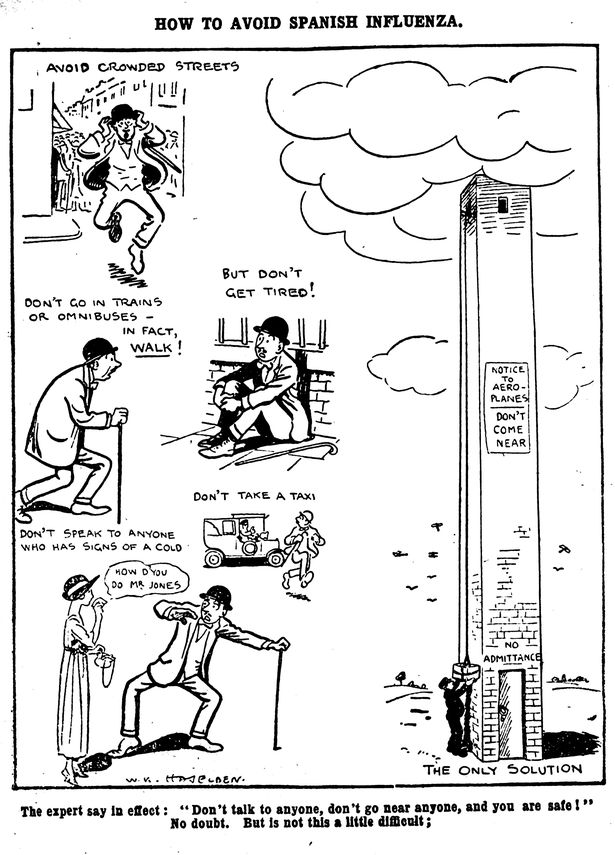
The epidemic was still on-going because a Jumble Sale on 23rd November was postponed for a fortnight “in consequence of the severe epidemic of influenza which has been raging in the Parish for the past few weeks”. The epidemic then went away over Christmas, but in the New Year returned to the Mixed School.
On Friday 17th January 1919, Attendance worsened steadily this week. Today 40 children are absent suffering from colds and croup.” On Monday 20th the Head reported, “Today 60 children present out of 125. There is every symptom of a whooping cough epidemic or some chronic throat and bronchial trouble.” On Friday 24th, because of a steady decline in numbers, the school was closed for a fortnight.
After the epidemic had subsided, the Medical Officer reported that there had been seven deaths in Holmes Chapel due to influenza. From the papers we know the names of four: Walter Denby (53), William Postles (32), George Pierpoint (41) and George Cartwright (52).
From the middle of February 1919 (Week 18), Holmes Chapel appears to have been finally clear of the epidemic.
This article was published in "The Villages Mag" September 2020
Click here to return to top of page.What Llyod George Wanted to Know (about your house)
If your house was built before about 1910 you can get an interesting snapshot of what the house was like at that time. This is thanks to a Budget presented by Lloyd George in 1909 which proposed taxing land which could have value beyond that of agricultural land. In order to identify this, a survey was carried out to value land all round the country. It produced detailed maps, including one of Holmes Chapel, on which the owner of every piece of land was identified. It also described any property on that land and who was living there at the time. So, for example we know that the occupier of the Police Station on Middlewich Road was Sgt Samson Bowyer. ‘The house was in good condition and had an office, a large living room, 2 cells each fitted with wooden beds and WC and a yard for exercising. Outside was a coalhouse a WC and a kennel.’
The records tell us whether the house had a water supply or used a well, what condition the house was in and how the waste water was disposed of. Very few houses had a water supply directly into the house and most drainage was into the nearest stream. Hot running water was very new and only the local plumber seemed to have this luxury. Electricity for most people was a dream and only two houses in the village, Sandiford and The Hollies had their own generator and batteries. The farms and small holdings were described in detail even saying how many cows they could accommodate and what was grown in the fields. For example there was tying for two cows at Saddlers Close, the home of Dr Picton.
All this information can be linked to the census which took place in 1911 so that for every house it is possible, with a little detective work, to not only have a description of the property but find out who was living there and how they earned their living. For any local historian or owner of an old house this is a treasure trove of information.
For those who want to find out more about an old property in Holmes Chapel, much of this information has been coordinated into a booklet called ‘Holmes Chapel around 1910’ which can be purchased from the Print Room in Church Walk.
Here is an example of what can be learnt:
In 1910 this cottage on Macclesfield Road was already old. There was a small garden area and paved yard with a pumped water supply. Accommodation comprised a living room, back kitchen and small wash scullery and 2 bedrooms. There was a coal shed and earth closet outside. The rent was £8pa. Over the door was a date of 1746 and the letters TBH indicating the house had been built or renovated by Thomas Bayley Hall who lived at the Hermitage and owned many properties in the area. Thomas Venables (66) lived here with his wife Sarah aged 62. He worked as a farm labourer.
This article was published in "The Villages Mag" October 2020
Click here to return to top of page.Thomas Royle Kay - WW1 Soldier
This is the story of Thomas Royle Kay of Holmes Chapel - a WW1 soldier –a Private in the King’s Regiment – a forgotten hero. He volunteered at the start of the war in 1914, and his Battalion moved to France, near Nieppe south-west of Armentieres on 25th September 1915. On 30th April 1916 he was part of the British forces subjected to a gas attack at Wulverghen. Some but not all of the defending troops had rudimentary gas protection helmets, however the attack caused 562 casualties of which 89 were fatal. In the summer of 1916, his Battalion moved south to the Somme valley. The Battle of the Somme took place between 1st July and 13th November where 419,654 British & Commonwealth casualties occurred with 95,675 killed or missing. Just on the first day, there were 57,470 British & Commonwealth casualties, with 19,240 men killed or missing.
On 14th July, at the Battle of Bazentin Ridge, his Battalion attacked the German defensive position at 3:25 am after a five minute bombardment. Field artillery fired a creeping barrage and the attacking waves pushed up close behind into no-man’s land, leaving them only a short distance to cross to the German front trench. The attack was successful, but was not followed up due to communications failures, casualties and disorganisation. The numbers of casualties are recorded as 9,194 with about 3,000 killed or missing. Thomas Royle Kay was one of the missing that day. He has no known grave.
Thomas’ mother Annie lived in Holmes Chapel with her mother and father. In the early 1880s, Annie’s father (Thomas Kay) emigratedto Australia and became a farmer. Then in October 1886, Annie and her mother were staying in the Australian Immigration home in London awaiting passage to Australia to join with her father, when she gave birth to Thomas Royle Kay. Records show that Annie’s mother continued to Australia two days after Thomas’ birth, while Annie returned to Holmes Chapel, where she later had Thomas christened in St Luke’s. In 1888 when Thomas was two, Annie abandoned him and left to go to Australia to be with her parents. Thomas spent his early life living in Holmes Chapel, but by 1901 (aged 15) he was living at Wheelock Wharf, where he learned the trade of a canal boatman. He met Elizabeth Hodson who belonged to an established Cheshire canal family with whom he had a son in 1908, Thomas Hodson Kay.
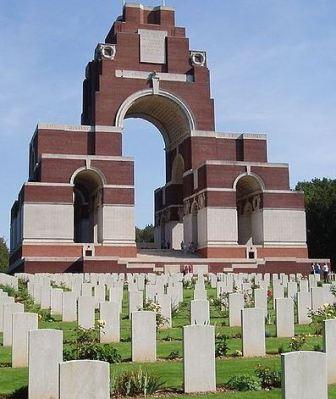
His name is inscribed on the Memorial to the Missing at Thiepval, overlooking the Somme battlefield, but nowhere else. Given that he grew up in Holmes Chapel, shouldn’t he be named on our Cenotaph, and remembered on our Roll Call every Remembrance Sunday?
This article was published in "The Villages Mag" November 2020
Click here to return to top of page.The Spy, the Red Lion & a Piece of Glass
Who would have expected that Holmes Chapel might have been the venue mentioned in a spy story from the days of Bonnie Prince Charlie and the 1745 Jacobite revolt? This may well be true.
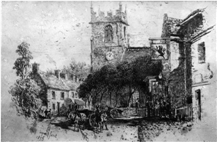 |
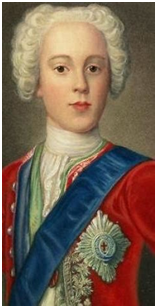 |
Captain John Vere (sometimes called Weir) was a British intelligence officer. According to one commentator, he was the most notorious spy of his time. Our story starts on 2 December 1745 when an advance party of Scots, went forward at night towards Newcastle-under-Lyme. When they reached the Red Lion at Talke (long since disappeared) they found a group of British soldiers including John Vere. Most of them escaped through windows but the Scots seized Vere, who they knew to be a noted spy. The initial thought was to execute him at once but instead he was tied behind a horse and taken barefoot to Congleton. There he was interrogated by Prince Charles and Lord George Murray. In order to save his life, he exaggerated the size and position of the army sent to quell the rebellion under the Duke of Cumberland. He told them that the British troops were in such numbers that the Jacobites stood no chance of survival. Lord George bluntly told the Prince that he and his army should return to Scotland, which they did shortly afterwards.
Now the story is not too clear, but there is a newspaper article in the Stamford Mercury of February 1746 which states that Vere escaped and had been seen at Holmes Chapel.

Though seen in Holmes Chapel, it was maybe still as a prisoner not escapee, as other reports say that he was taken to Carlisle by the Scots and subsequently released by the English after the fall of Carlisle Castle.
Did Vere and his captors stop a while at the Red Lion in Holmes Chapel, at that time an important coaching inn? If they did, it might explain the pane of glass on a window on the first floor which has inscribed on it “and preserve Prince Charles Amen I prey God”, perhaps left by his captors. After his release, Vere subsequently gave evidence in the treason trials that followed against Jacobite prisoners. One Scottish commentator wrote “This Vere….. was conducted back with us to Carlisle - how unfortunate for us, that he was not put to death, considering what he has since done!-but his life was saved through the innate clemency of the Prince, though he merited the worst punishments.”
No one knows for sure how that pane of glass ended up in a window at the Red Lion, but this is one possibility.
This article was published in "The Villages Mag" December 2020
Click here to return to top of page.Road Developments in Holmes Chapel
Holmes Chapel grew, probably from the 13th century, at the junction of two routes. The main route was the north-south road known from early medieval times as the Great Route to the North, providing a link between London and Carlisle and pre-dating the Great North Road on the east side of England.
For centuries, road travel was by walking or horse. The horse was usually ridden, but eventually waggons drawn by teams of up to eight horses would haul large loads and later the trap and carriage appeared, having been developed in Europe. These though, were the preserve of the rich; most people still walked, with journeys of up to seven miles being commonplace.
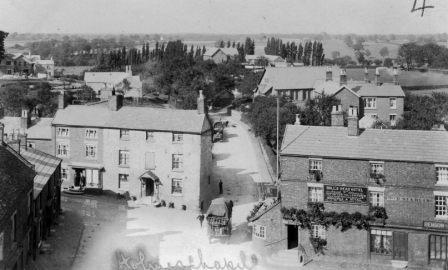
The Square Looking North
The roads themselves were poorly maintained, just tracks with no durable surface; dry, hard and dusty in summer and either a mud-bath or covered in snow and ice in winter. A journey from Glasgow to London in 1758 took 12 days on horseback. What little road maintenance carried out was provided under law by the parishes, with four days unpaid labour required of each parishioner. Inevitably, such work as was done focused on the parish itself. Roads between parishes were still poorly maintained. Thomas Steel is recorded as being appointed Surveyor to the township of Church Hulme in 1727 with responsibilities to provide cart-ways and horse causeys to market towns.
With increasing trade and commerce, the inadequate state of the roads became a serious issue and laws were passed by Parliament permitting local Justices to charge tolls which were used to improve the roads. This proved insufficient so further legislation was enacted to allow the formation of Trusts which had the rights over a length of road and could erect gates surmounted with pikes and toll houses to enforce payment for passage. They could also borrow money to improve the roads, paid for by the toll charges. These were the turnpike trusts. There were three turnpikes through Holmes Chapel - Lawton to Cranage (now the A50) opened in 1731; Nantwich to Congleton via Middlewich (now the A54) opened in 1753 and Holmes Chapel to Chelford (now the A535) opened in 1797.
The last one is of the most interest locally as the toll house still remains, now incorporated into a house, just east of Saltersford Bridge and well worth taking a look at. The Lawton-Cranage turnpike had a toll gate at or near Iron Bridge Farm, according to a map of 1842. Further north there was another toll gate at Cranage on the site of what is now the tyre depot. Other notable features along many turnpikes were smithies. On the Lawton-Cranage turnpike they could be found at Cranage, Holmes Chapel, Brereton, Arclid, Smallwood and Rode Heath. No doubt all the horse drawn traffic provided plenty of business!
Turnpikes were not universally welcomed. Manufacturers and traders benefitted from easier and faster movement of goods, but costs were increased by the toll charges. It is recorded that Edward Hall (Snr) of Cranage Forge complained that the toll costs were too high, given the number of waggons bringing limestone and coal in, and shipping finished goods out. The Turnpike era lasted until the 1880s when responsibility for road maintenance was given to the new County and Borough Councils, but they had been in decline since the coming of the railways from the 1840s.
This article was published in "The Villages Mag" February 2021
Click here to return to top of page.Holmes Chapel Stagecoach Services
The first stagecoach services in England began in the early 1600s, but were restricted to summer only travel due to the abysmal state of the roads. Fifty years later routes from London were serving several Northern towns including Preston. It is possible, but not certain, that the Preston service passed through Holmes Chapel, given its location on the historic Great Route to the North. Journey times were in days as only one team of horses was used, but by 1734 the system of “staging” horses, i.e. exchanging them approximately every 10 miles became common practice. This lifted average speeds from 5-6 mph to 9-10mph – a halving of travel times.
The earliest record of the Red Lion Inn in Holmes Chapel is from 1625. It would have been well placed to provide accommodation and hostelry for passing coaches, a demand which would both grow and sustain it over the next 200 years. There must have been steady progress in stagecoach services locally, as Dick Turpin, the infamous highwayman of the 1730s, was recorded as frequenting Ye Olde Black Bear in Sandbach. He wouldn’t have been there just for the ale!
By 1760 the “Flying Machine” coaches were calling twice a week at the Red Lion, en-route between London and Warrington / Manchester. The one-way fare was £2 2s (£2.10) inside, with half fare for an outside seat. You must have had fortitude for that!
Another significant part of the development of road transport was the mail coach. The Post Office had used post boys on horseback for many years and was resistant to the use of stagecoach services. Following a protracted campaign mail coach services commenced and grew rapidly. By the time of their demise, mail coaches were running some 136 routes, using 700 coaches. The London-Manchester service ran via Congleton, missing out Holmes Chapel, but the Royal Mail from Liverpool to Birmingham did call at the Red Lion.
Services had expanded rapidly through a combination of improved coach design, better roads and horse staging, delivering faster, more reliable services. Some idea of local services can be seen in the following table of coaches calling at, or passing through the village in 1830 and running to a fixed timetable, which was quite a feat for its time.
| SERVICE | ROUTE | RED LION | GEORGE & DRAGON | BEAR'S HEAD BRERETON |
| THE AURORA | Liverpool -Birmingham Daily |
21:15 (S) 15:45 (N) |
||
| THE BANG-UP | Liverpool-Birmingham Daily |
13:00 (S) 14:00 (N) |
||
| THE ROYAL EXPRESS | Liverpool-London Daily |
20:30 (S) 15:00 (N) |
||
| THE ROYAL MAIL | Liverpool-Birmingham Daily |
24:00 (S) 03:00 (N) |
||
| THE UMPIRE | Liverpool-London Daily |
19:00 (S) 11:30 (N) |
Stagecoach services became a huge business, which at its peak required over 150,000 horses and employed very many people. Sadly, the advent of railways spelt their demise. Nationally, some services lasted until the 1880s, but the golden era was long gone. Technological progress had killed them off and no longer would a coach and four clatter through the village.
This article was published in "The Villages Mag" March 2021
Click here to return to top of page.Sandiford Cottage
On the site of the Holmes Chapel Fire Station once stood a large house in extensive grounds, which were bisected by the Sandyford Brook. This was Sandiford Cottage, built in the late nineteenth century as a private home, but which had many uses before it was demolished to make way for the fire station and the shopping precinct. Some of the outbuildings, converted into a smaller house, still stand at the rear of the present day barber’s shop, once the village post office. In the 1880s Sandiford Cottage was the home of the Misses Royd; by 1891 it was occupied by Sydney Roberts, a chemical manufacturer, and his family and servants. In 1897 the Holmes Chapel and District Horticultural Society was allowed the use of the grounds for the annual flower show, with a show tent, band and amusements and the tea tent in the adjoining field, a privilege which was to continue when Frank A Haworth became the tenant. The Land Tax Survey of 1910 records that the house had six bedrooms, two nurseries, two bathrooms and a servants’ hall, with four bedrooms for staff, making it a very substantial residence, lit by electricity when most homes relied on oil or gas lamps. Outside there was a coach house, stables and loose boxes, a garage, engine and cell house and even a schoolroom. Mr Haworth had, that year, bought the house for £2,300.
Frank A Haworth was a pillar of the local community, serving on many committees, including the fund for Belgian refugees who came to Holmes Chapel during the First World War. He was active in recruiting local men for Kitchener’s army and the Volunteer Training Corps for home defence, serving in the latter himself and hosting band concerts in the garden of his home. However, once the war was over he seems to have moved out of the property, and it was rented by the Church of England until a newly built vicarage on London Road was ready in 1930.
The spacious accommodation proved useful when the Second World War broke out. Already used by the Women’s Voluntary Service and the TocH organization for veterans of the 1914 – 1918 conflict, it was requisitioned by the government and housed a unit of black Americans destined for the D Day landings and, later, by German prisoners of war from late 1945 until 1947. It was then purchased by Congleton Rural District Council for use as offices and a meeting place for local groups including the Scouts and Guides and for older people. By the 1960s change was in the air and Sandiford House, as it was sometimes known, had to make way for other uses.
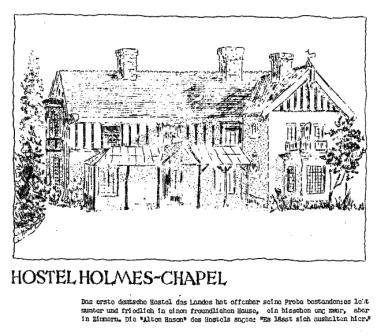
This sketch is from a postcard given to the German prisoners to send to their families. The caption, roughly translated, says that the house was friendly and life was lively but peaceful, though the rooms were a bit cramped. I doubt if the Misses Royd or Frank A Haworth found them so, when circumstances were different!
This article was published in "The Villages Mag" April 2021
Click here to return to top of page.Holmes Chapel in 1869
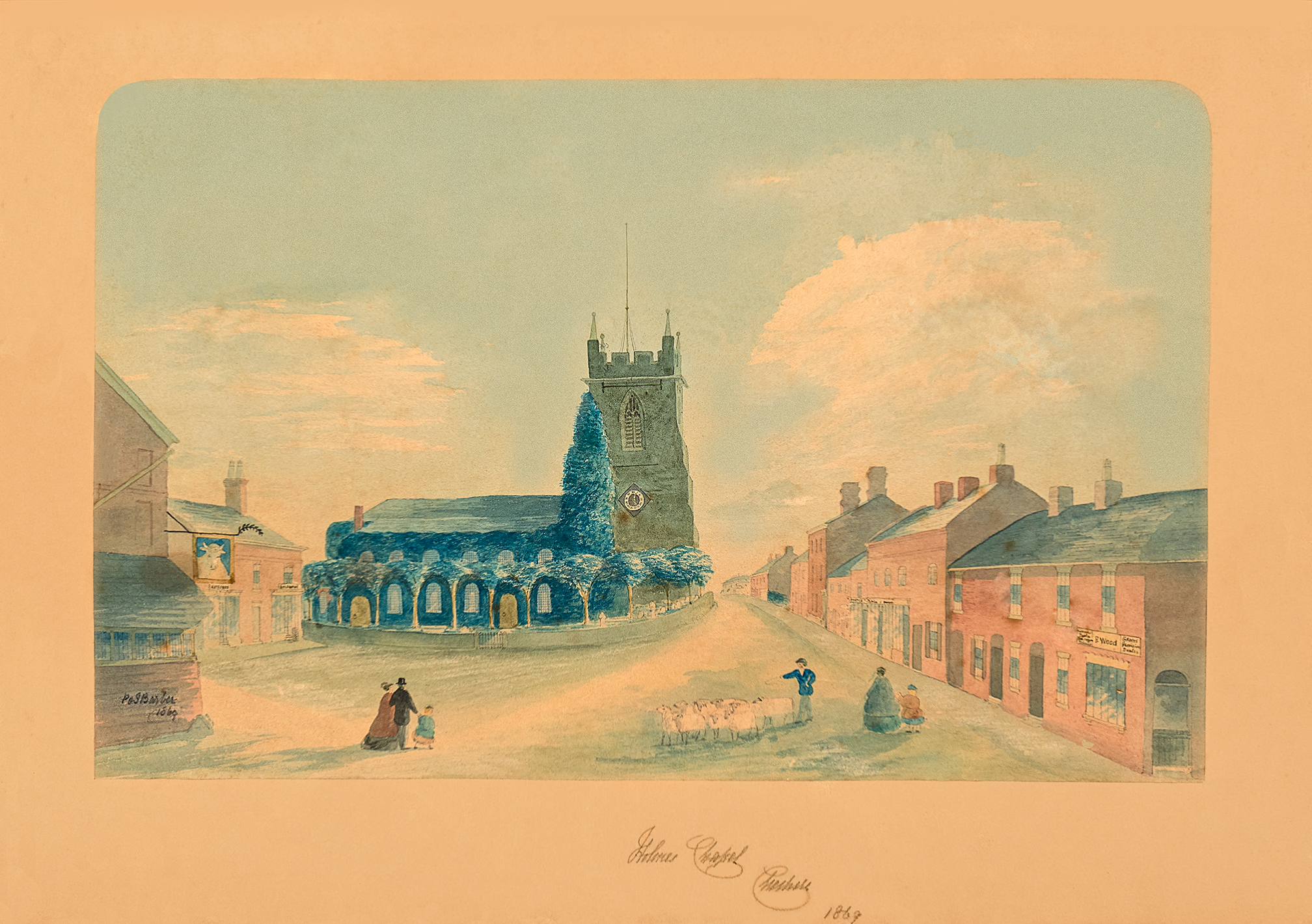
This image of Holmes Chapel was painted in 1869 by P Barber but nothing is known about the artist. It was presented to the village in 2013 by the then owners, the family of Dr Arthur Picton, and hangs on the wall of the Parish Council office. More recently a second copy has come to light which is almost identical. It is interesting to see how you can still recognise the view as Holmes Chapel today. Although a simple water colour the picture tells you a lot about the village at the time and all the shop names have been found to correspond to information from the 1871 census. Thus, it is believed to be an accurate record of the village at that time.
To the left is the Bulls Head Inn which has been demolished and beyond it two shops which are on the site of Barclays Bank. In the first of the shops lived William Antrobus the Postmaster running the Post and Telegraph Office. He was also a tailor and his wife was a milliner and dressmaker. Next door was Henry Bolshaw a grocer. These shops were destroyed by fire prior to the building of the Union Bank (now Barclays).
The church is largely unchanged but at the time it was ivy covered and lime trees were planted around the edge of the grounds. These had been planted in 1743 at a cost of 12 shillings.
To the right of the Square the first building, which is now Bella Casa, has the angled doorway we can still see today. This was a Grocer and Provision Dealer run by Phillip Wood and the sign says it sells tea, coffee and tobacco. Next door are three properties the first occupied by William Wharton and his wife who are both tailors. Next door, down a passageway is Thomas Plant a saddler and then the other side of the passage, where Costa is today, was Samuel Lea, another tailor.
The shop window next door has the sign Harrop. This would have been Harriet Harrop who was a milliner, a maker of lady’s hats. Next door was the shop of Joseph Thorley who was a boot and shoemaker while his wife was a draper. In the shop which is now part of Sainsbury’s was Eliza Carter, the widow of George Carter. She was a draper and tailor employing two men.
At the end of this row is the tall building opposite the church. This was Beech House, the home of John Oldfield, his wife and daughter, a retired butcher. The three cottages between Beech House and Eliza Carter’s tailors shop were occupied by a retired postmaster, a wheelwright and then a dressmaker.
This painting is a valuable record of life almost 150 years ago when a village like Holmes Chapel provided for all the needs of the residents from meat to groceries to clothes.
This article was published in "The Villages Mag" May 2021
Click here to return to top of page.The Development of Public Transport in Holmes Chapel (Part1)
The arrival of the railway in Holmes Chapel in 1841 brought about a revolution in transport, but the local impact would be gradual. One aspect was competition with the stagecoach services running between Liverpool and Birmingham / London. The railway soon proved to be faster, more reliable and comfortable. By the 1880’s most stagecoach services had gone as the rail network grew, providing connections to more destinations.
In the large towns and cities developments were taking place in urban transport with horse buses and tram networks. Manchester had well established services of both by the 1880s, but rural locations such as Holmes Chapel saw little change or progress, not helped by legislation prohibiting mechanically propelled vehicles on roads until it was repealed in 1896 – the infamous Red Flag Act. The Turnpike Trusts had little liking for mechanically driven vehicles either, imposing high tolls to discourage their use. There was no public transport to places such as Knutsford, Congleton or Middlewich. It would take both the development of the petrol engined bus and the transfer of roads to local authorities for that to change.
A horse bus service existed between Chester and Kelsall in the early 1900s, being replaced by a motor bus in 1909. This is one of the earliest records of “omnibus” services in Cheshire. Interestingly, Edwin Foden had begun manufacturing steam powered lorries in Sandbach by the early 20th century, but there is no record of any local buses being steam powered, though waggons were often “converted” for passenger use, mainly for excursion purposes.The first mention of any local bus services is by the Mid-Cheshire Bus Company (M-CBC), based in Northwich. They began offering Sunday tours through the Cheshire countryside and one destination was Holmes Chapel. When or if they offered what became known as “stage carriage” services to Holmes Chapel is unclear. The first real progress came from developments in Macclesfield.
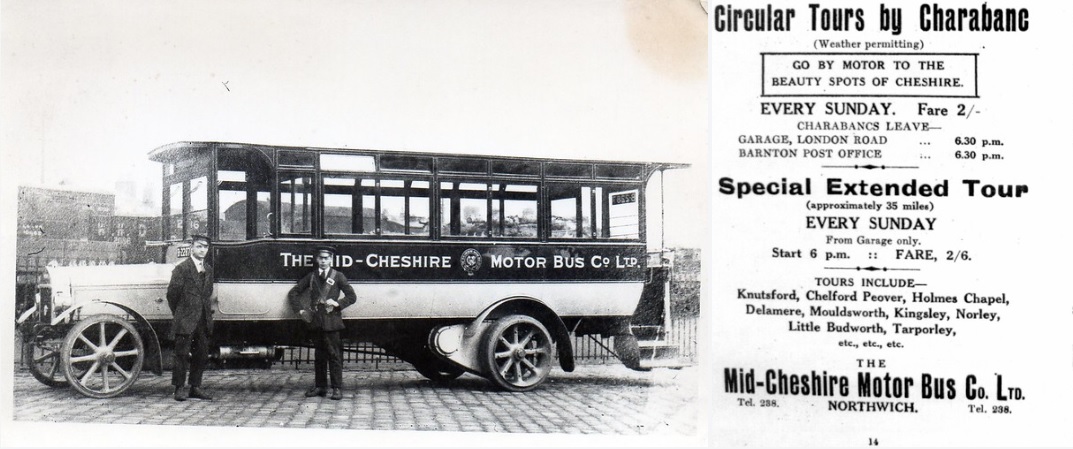
The development of bus services is a complex story involving two major private companies, British Electric Traction Company (BET) and Thomas Tilling, together with Municipal Authorities and the Railway Companies. Ownership of many bus services was shared between the two private companies and the railways until nationalisation in the late 1940s. Suffice to say that locally two companies were dominant: The North Western Road Car Company (NWRC) which covered east Cheshire and the Crosville Motor Company (Crosville) with its territory in west Cheshire and Wales. From its origins as the “British” company owned by BET it became the NWRC in 1923. In 1924 the business was on the acquisition trail, its first conquest being M-CBC in 1924. Just one year later, regular bus services commenced through Holmes Chapel, being operated from Mid-Cheshire’s Northwich Depot.
The development of NWRC’s services continued apace throughout east Cheshire and beyond. The earliest route map shows just one service into Holmes Chapel from Northwich via Middlewich. By 1928 services through the village were Northwich to Congleton (3 services a day) and Northwich to Goostrey via Middlewich (4 services a day). Services steadily expanded, though Holmes Chapel would never enjoy the service levels of nearby towns.
Long distance express services were introduced in the 1930s, connecting the north-west with London. Holmes Chapel was a recognised calling point for these services until they were diverted to the faster M6 motorway.
Part 2 will follow soon.
This article was published in "The Villages Mag" July 2021
Click here to return to top of page.The Development of Public Transport in Holmes Chapel (Part2)
As bus services became more extensive and the operators grew, governments began to take more interest and inevitably regulation followed. Legislation was enacted over the years, starting with the 1930 Road Traffic Act. The network of bus services nationally, expanded greatly, until curtailed by WWII.
In 1929 North Western Road Car Co., (NWRC) provided just one bus service into Holmes Chapel (HC) from Northwich but by the mid 1930’s it had doubled, with services from Northwich to Congleton via Lach Dennis (F,S,Su only) and Northwich to Goostrey via Middlewich, (daily).
Information relating to wartime services is scant, so we must look to 1947 for a picture of how services had progressed. NWRC had now acquired many smaller operators and dominated local services, which included:
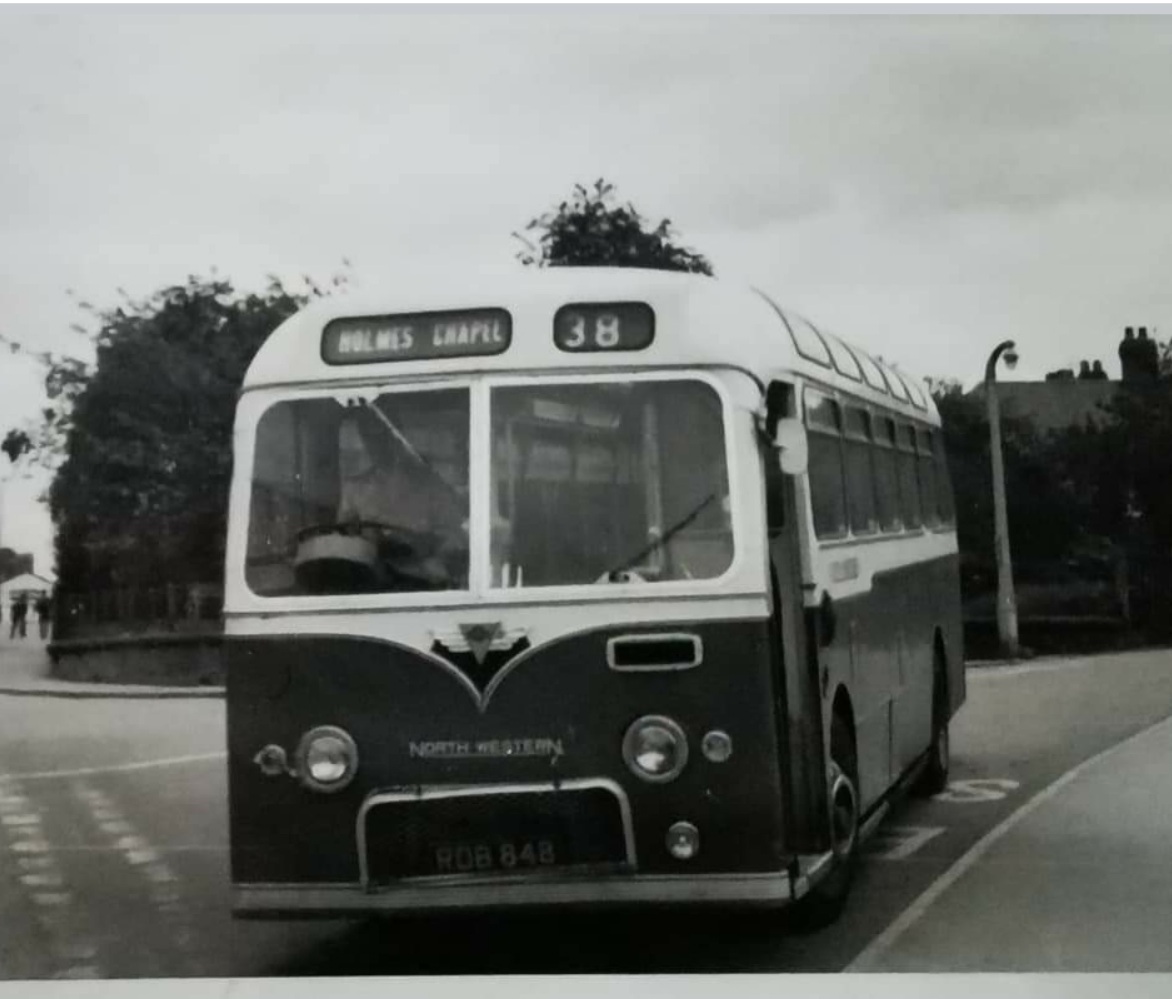 38/39
Congleton to Manchester via HC & Knutsford (Tu,S only).
38/39
Congleton to Manchester via HC & Knutsford (Tu,S only).
39A Congleton to Knutsford via HC (Not Su) with onward connections at Knutsford.
130 Northwich to Goostrey via Lach Dennis & HC (F,S only). Anyone remember the Cranage Tea Rooms which was one of the stops?
177 Radnor (Congleton) to Sandbach via HC (Th only) – a puzzle that maybe someone can explain?
In the mid 1960’s the 38/39/39A & 130 services were much the same; the 177 was now running from Hulme Walfield to Sandbach via HC, still only on Thursdays.
As mentioned earlier, government legislation was a constant factor. The 1947 Act nationalised most bus services, with further modifying Acts in 1953 & 1962, but it was the Act of 1968 that made far-reaching changes, particularly in city regions. It brought into being the Manchester PTE and SELNEC bus operations which in turn led to the demise of NWRC. Its services in east Cheshire were transferred to Crosville, who had historically operated in west Cheshire & Wales.
In 1974/5 as Crosville established revised service patterns and new route numbers, HC lost out with the Altrincham-Congleton service H48-50 only operating on Saturdays, though you could catch it on weekdays from Lower Peover! The 130 service was cut back to Allostock & the 177 service seems to have vanished.
Some years earlier, Potteries Motor Traction (PMT), had taken over the circular service from Sandbach to Goostrey via HC (known by some as the Potteries Muck Truck!) It’s clear this was a popular service which linked to other routes at Sandbach and even allowed you a Saturday night out in the town - last bus back at 10.00pm! Later it became the 327 service operated by PMT, Bostocks & Crosville jointly. Subsequently a variety of operators ran this service under Council contracts, as the 319. Now there are just four services M – F only, operated by D&G Buses.
Mention must also be made of schools services. In the days before Holmes Chapel “Comp”, pupils were bussed to Congleton, Middlewich & Sandbach. A number of local operators ran these services including Bostocks, Coppenhalls & Niddries. One pupil recalls that the gear lever could be unscrewed from the latter’s bus and hidden, delaying the journey to school!
1986 brought deregulation, probably the greatest change the bus industry had ever seen. Chaos ensued as multiple operators chased profitable routes, but small communities lost out. By the early 1990’s Cheshire County Council (CCC) had stepped in to bring some order back to services. Their Rural Rider branding returned stability, albeit with subsidies. Services through HC saw significant improvement.
The CCC Rural Rider scheme introduced the 41 service from Congleton to Nantwich, via HC, with an extension to Stapeley Water Gardens (another memory), operated by PMT. Later changes saw the 42, D&G Buses service introduced, which ran from Congleton to Crewe. In 2014 the contract was awarded to GHA Coaches who invested in a new fleet of buses with Gold route branding. Sadly, GHA went bust in 2016 and the service reverted back to D&G. In 2017, subsidies were reduced and the service was cut back.
A few other, limited duration, services have existed over the past 30 years, including 49, Sandbach to Northwich & Aston-by-Budworth (S only); E69, HC to Altrincham (S only) and the X78 HC to the Festival Park, Hanley, operated by PMT, which lasted just a year.
It is approaching a century since the first buses came to HC. Who knows how services will develop over the next one?
This article was published in "The Villages Mag" August/September 2021
Click here to return to top of page.The Hermitage and its People

Of a religious hermit ever living at The Hermitage, there is no record,
though it was granted to the Hospital of St John of Jerusalem in the
12th century. By 1400 it was held by the Cranage family who also took
the name of ‘Ermitage’. It passed by marriage to the Winnington family
who lived there from 1430 to 1650.
The Winningtons maintained a chapel in St Luke’s Church for their
private use which was extended in 1577 by Thomas Winnington during the
reign of Elizabeth I. He may have rebuilt the house, which would have
been timber framed with a stone slab roof, decorative bracing and
elaborate chimneys, elements of which survived later alterations.
During the Civil War the Winningtons were Royalists and in 1647 were
fined £411 to be paid in annual amounts of £40 to Goostrey church.
Possibly as a result of this in 1650 they sold the house and estate to
John Leadbeater, a Parliamentarian.
In the next generation John, who was the second son and owner of the
forge at Cranage Mill, was bound over not to act against King or
country. His older brother Thomas was imprisoned in 1663 for ‘anti
royalist activities’. He was not only a Parliamentarian but he was also
a keen Non-conformist and by 1672 his home was licensed for preaching.
It was a substantial mansion, taxed for thirteen chimneys in 1668.
Thomas died in 1679 and was buried at Holmes Chapel. His son, another
John, sold The Hermitage to Thomas Hall of Cranage in 1702.
The Halls were wealthy iron masters and the village benefitted from
their influence for the next 110 years. The church of St Luke was
substantially rebuilt at Thomas Hall’s expense in the early 1700s and
Hermitage Bridge in 1707. At the same time he added a new brick wing on
the south side of the Hermitage itself. The initials TBH can still be
seen on several properties built or improved by the last of the line,
Thomas Bayley Hall, who died in 1828. The estate was then sold to
Lawrence Armitstead, a local landowner.
The Armitsteads were vicars of Goostrey, Holmes Chapel and Sandbach at
various times during the next 120 years. John Armitstead, half brother
to Lawrence, lived at the Hermitage in preference to the vicarage (now
The Vicarage Hotel), while he was vicar of Holmes Chapel from 1825 to
1846, when he moved to Sandbach. From then on, whilst still in
ownership of the Armitsteads, The Hermitage was occupied by a
succession of tenants.
Hubert Wilson, who owned Newton Heath Brewery in Manchester, rented the
house in 1890 and bought it in 1896. He made many alterations and
extensions, including a new lodge house on the rerouted access road and
improvements to the gardens and grounds, where 18 gardeners were
employed. They left in 1909 and rented their former home to Mr Henry
Reiss, a shipping merchant originally from Germany. He and his wife
were active fundraisers in the village during the First World War and
one of their sons was killed in the conflict. Afterwards the house was
sold to Mr F Cornall who lived there from 1926 to 1939.
During the Second World War it was occupied by American officers, whose
presence was still evident in the outbuildings at the Hermitage even in
the 1980s! After the war the house was bought by Manchester University
who never used it and sold it on in 1949, when it was divided into
three separate dwellings (requiring the demolition of the 16th century
and 1906 wings) and was featured in Cheshire Life. Perhaps
surprisingly, this subdivision was reversed between 2002 and 2008 when
the remaining fabric was restored and it became one dwelling once more.
It has recently been sold – again!
This article was published in "The Villages Mag" October 2021
Click here to return to top of page.Christmas Past in Holmes Chapel
We might be forgiven for thinking that Christmas 2021 might be a difficult one, with Yuletide spirit subdued by the continuing pandemic and economic turbulence, but the evidence suggests that Christmases past have sometimes been celebrated in times of hardship, but celebrated nonetheless. The exception to this may have been in 1652 during the Commonwealth when Puritans in Parliament banned feasting, dancing and even church services on Christmas Day! We don’t know if the people of Holmes Chapel complied with this edict but it is tempting to think that they refused..... There is a strong tradition in Cheshire of mummers’ plays featuring St George, the dragon, a hobby horse and a quack doctor, where men in disguise would go from house to house to perform the story in exchange for food or small sums of money. Versions from Comberbach and Antrobus survived until quite recently but again, we don’t know if there was once a troupe in our village.
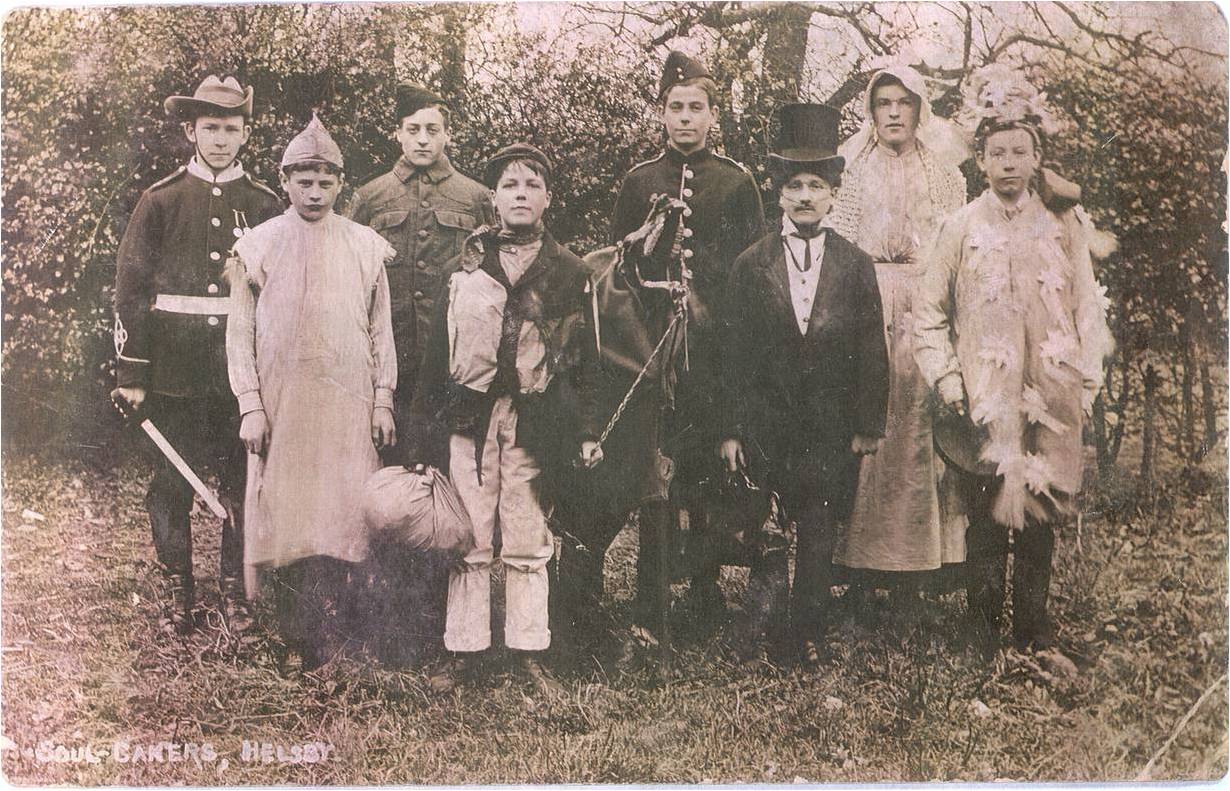
We are on firmer ground when we look at the nineteenth century. The Victorians introduced many of the traditions we associate with Christmas such as the Christmas tree, the Christmas card and the Christmas cracker, and revived the old tradition of carol singing. The Parish Magazine reported that in December 1891 over 100 children from St Luke’s Sunday School and some of the old people attended a Christmas tea at the Assembly Rooms (now Church Walk), the highlight of which was a magnificent tree full of presents from which each child took a present and a card. Indoor games followed, and each guest went home with an orange and a bun. The same magazine reported the distribution of parish doles, small amounts of money given to the poor of Holmes Chapel, Cotton and Cranage on St Thomas’ Day, 21st December. The Christmas tea was soon moved to the old school building on Macclesfield Road (now the Catholic Church) but was clearly a much anticipated annual fixture for years. In 1909 a conjuror entertained the audience and over 200 dolls, footballs, musical instruments and other presents were given out. Wealthier residents were expected to donate generously and to attend the festivities, and even during the dark days of the First World War when there were shortages of food and toys the tea parties carried on. However, several of the regular teachers were busy nursing wounded soldiers at Somerford Hall Hospital and new recruits were sought. Even the children took part in the war effort – the Magazine for December 1914 mentioned Queen Mary’s Work Fund which gave out wool to be knitted into socks, belts and mufflers for soldiers and sailors. By 1916 the tree had had to be replaced with a smaller bran tub, though the church itself was decorated with greenery as usual, and 80 Christmas parcels were sent to Holmes Chapel men serving abroad. By 1918 the first wave of the Spanish influenza pandemic had struck, making it impossible to get the parcels ready in time. Postal orders for 10 shillings were sent instead, a remarkably generous gesture given the hardships at home. The December Magazines through the Second World War reveal a similar determination to carry on, have fun and show generosity to others, though children attending the Sunday School tea had to bring “a spot of tea, sugar and margarine” and paper itself was in short supply.
This article was published in "The Villages Mag" December 2021
Click here to return to top of page.Holmes Chapel in the 1950s
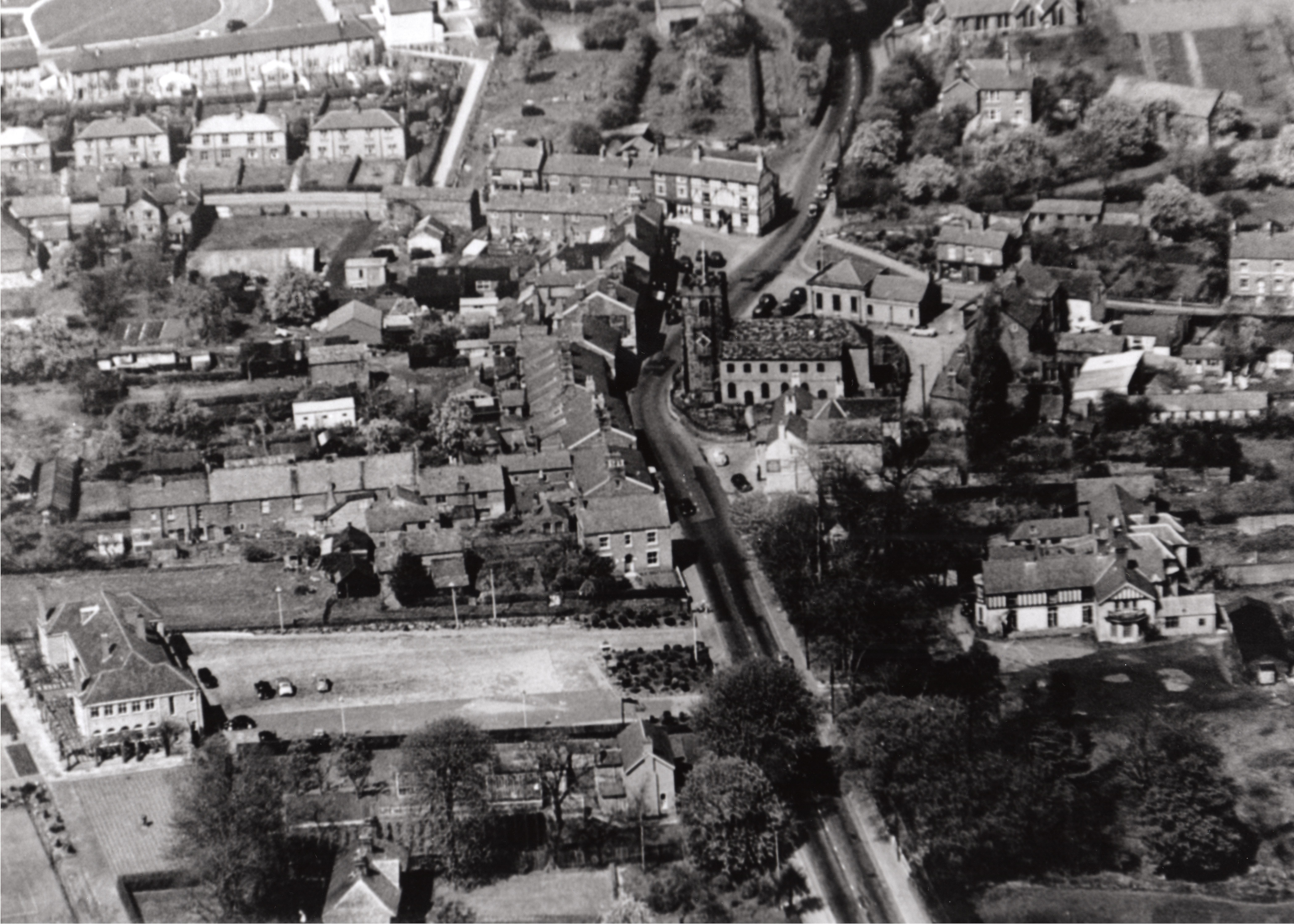
This aerial photograph of Holmes Chapel is dated 1955, though it is thought that it may have been taken in 1950 or 1951 as the postwar housing on Middlewich Road and Northway is known to have been completed by then. Certain parts of the scene have changed very little, whereas others are barely recognizable.
The Methodist Chapel is there at the top right hand corner and, of course, St Luke’s is at the very centre of The Square, with the churchyard still encircled by the lime trees which had to be removed in the 1960s. Close by is the bank, and the shops opposite and the houses and cottages at the rear and those on Macclesfield Road all look much the same today, as does the Red Lion and Brook Cottage, better known as the recently vacated carpet shop on the west side of London Road, facing south. Much has changed, however. Just visible at the rear of the old George and Dragon is Sadler’s Close, the home and surgery of the first Dr Picton and his family, demolished to make way for Crofter’s Court, though the name has been preserved. Next to the Chapel stands the original Hawthorne Villa, demolished to make way for Hawthorn Villas. The old George and Dragon and the shops in the adjacent row were taken down in 1969 when the pub was rebuilt slightly further back. The old Bull’s Head on the opposite corner of a difficult junction had gone in 1948 and was not rebuilt. What is now Church Walk was then a row of buildings, including a cottage, shop, outbuildings and the Assembly Rooms, the only public hall in the village from about 1870 until the Victoria Club was built in 1924. Between 1949 and 1957 the Assembly Rooms were used as a cinema. Just to the south was The Good Companions road house with its very large car park, now Lovell Court, and next to that stood Brook House, now the site of Sandringham Court. On the opposite side of London Road, where the shopping precinct now lies, was Sandiford House, a substantial property with a varied history. Only the servants’ quarters remain, converted into a house, and the Fire Station occupies the actual site of the much larger original building. Just visible through the trees can be seen the white gable of what was, in the 1950s, still the village Post Office, run by the Sankey family for several generations. This building, now occupied by a barber’s shop and cafe, is all that remains of the stabling and outbuildings of the old Red Lion coaching inn.
If you are interested in seeing more photos of Holmes Chapel and district in years gone by, have a look at our online Photo Archive www.holmeschapelphotos.co.uk
This article was published in "The Villages Mag" February 2022
Click here to return to top of page.A Landowning Dynasty – the Hodges family of Holmes Chapel and locality
Another of the more substantial houses no longer here was Lane Ends House, a mansion built around 1700 on the south eastern corner of the crossroads on London Road at the southern end of the village. It is not known who built it, but for over sixty years it was the home of the Reverend Thomas Hodges, the longest serving Vicar of Holmes Chapel. It was an impressive Georgian house of brick, with a parapet, many windows, projecting wings at either end, ornamental porch and many rooms and outbuildings, standing in extensive grounds. Remaining in the same family through several generations, it was eventually sold to Cheshire County Council in 1939 for a road widening scheme, the problem being that it stood only a few metres back from an increasingly busy junction. The only trace of it still to be found on the site are some ornamental stone caps repurposed as part of the garden wall of a property built on the site.
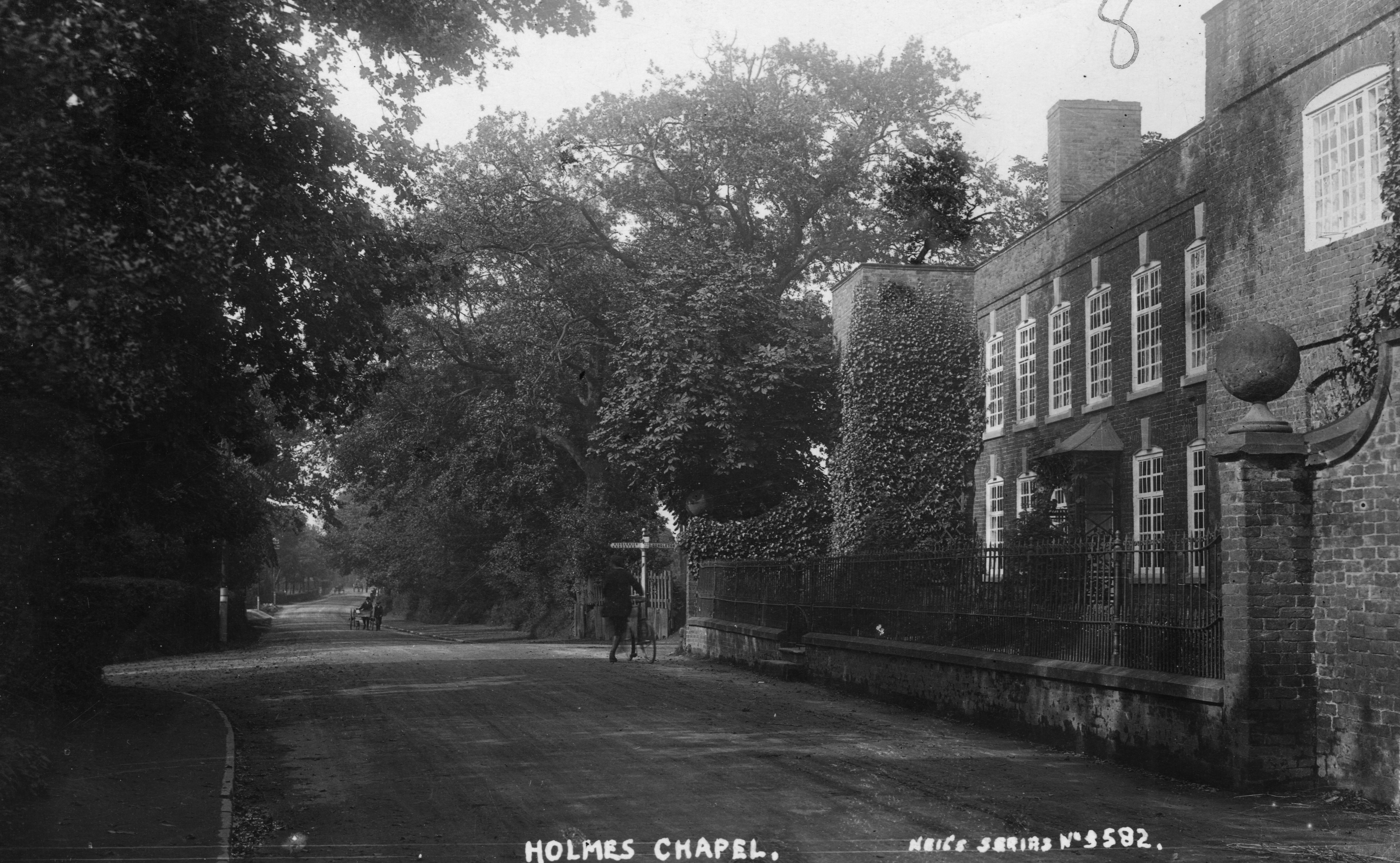
Reverend Thomas Hodges was the son of a Shropshire gentleman and a graduate of Hertford College, Oxford. He came to Holmes Chapel in 1757 and served the parish until his death at the age of 88 in 1821. He is buried in a vault underneath St Luke’s and there are memorials to him and other members of his family in the church. As befitted a gentleman, he insisted on riding to services and a wooden bar for holding his saddle is still to be seen in the church porch. He married twice, his first wife being Ann Wilcoxon, the widow of a lawyer with an estate in Sproston, and his second being Mary Hilditch, a local spinster who may have been a servant in his household. The second marriage produced five children, three sons and two daughters. The eldest son, Captain William Arthur Hodges of the 47th Regiment in Wellington’s army was killed in action at St Sebastian in Spain in 1813 at the age of 26. His two brothers went into the church, both serving as curates to their father at St Luke’s in their younger years. The younger of the two, Charles Bishope Hodges, inherited Lane Ends House and lived there for the rest of his life, though he was vicar of Congleton and then Byley. He left the house to his daughter in 1864, and his granddaughter sold it to her cousin Thomas Clayton Toler in 1918. There were periods of tenancy in its history, but it was owned by descendants of Reverend Thomas Hodges from 1757 until 1939.
The other brother who went into the church was another Thomas Hodges (Junior). He built Saltersford Hall, which eventually passed to the Toler family by marriage and later became an agricultural college and then a reform school. Thomas Clayton Toler was the grandson of Thomas Hodges Junior of Saltersford Hall and lived at Lane Ends House from 1918, though he moved to Swettenham Hall in 1930
This article was published in "The Villages Mag" March 2022
Click here to return to top of page.Road Plans in Holmes Chapel, 1938
Widening the road through the village – In July 1938, plans were going ahead to destroy half the village in order to finish widening the A50 trunk road. Parts of the road had already been completed, such as the three lane stretch to the north running up to Allostock, and the three lane stretch to the south towards Brereton Green. Between 1935 and 1937 the County Council had also doubled the width of Cranage Bridge over the river Dane. On the 2nd July 1938, the Crewe Chronicle reported:
“RE-BUILDING THE VILLAGE, WHOLESALE DESTRUCTION OF PROPERTY. Some day in the near future the quaint picturesque village of Holmes Chapel will be obliterated by the wholesale destruction of property in the centre to make room for the Ministry of Transport’s new trunk road, Winchester – Preston. The left [West] side, from Mrs Barraclough’s house to the George & Dragon will in accordance with the present proposals be demolished, and the new business establishments which are chiefly affected, are to be erected on a building line to the rear of the existing premises. Property along Macclesfield road is, we understand, to share a similar fate in connection with the big scheme.
Had it been possible to move the ancient church, which causes the serious obstruction in the centre of this busy highway, many thousands of pounds would have been saved. The owners of the property concerned have been notified by the Ministry of Transport of the steps to be taken to acquire compulsorily the premises which are involved in the scheme, and objections have to be filed by 18th July this year. Tradesmen are perturbed in no mild degree over the drastic measures to be adopted, and an attempt is being made to form an association so that the problems with which they will be faced can be met in some united form instead of acting individually.
Former residents of the village who will revisit the place in a year or two’s time will see a great transformation, and an old-world village modernised, with only the old church remaining to remind them of former days.”
Any objections submitted must have proved unsuccessful because the Crewe Chronicle reported on 15th October 1938: “BY-PASS PREPARATIONS – Property owners whose buildings are to be demolished to make way for the by-pass road have now received official notices and plans for the requirements of the authorities.”
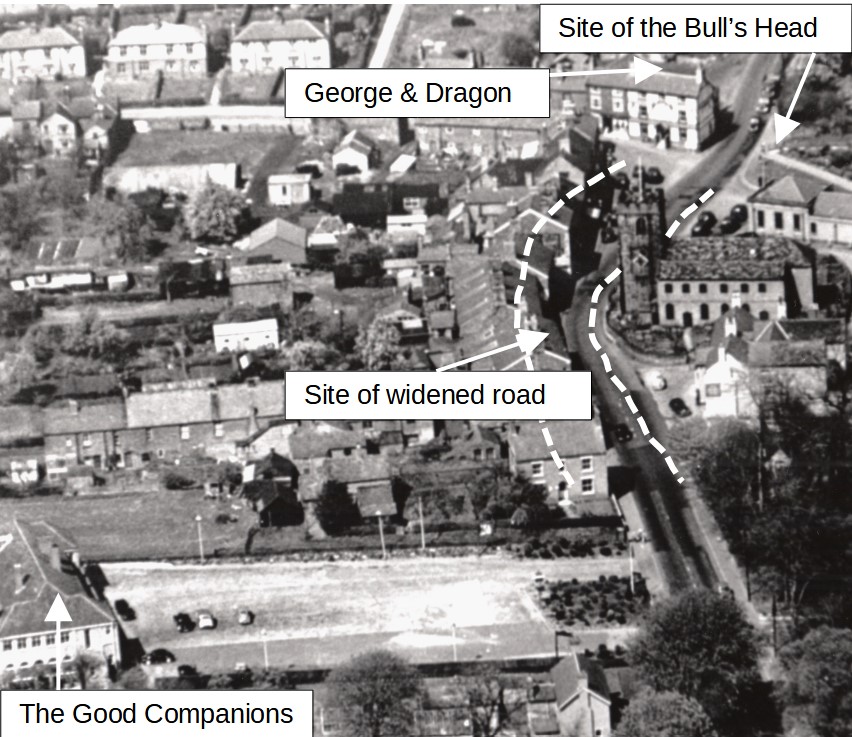
However, war clouds were looming and at the eleventh hour the demolition was cancelled. The demolition of the Bull’s Head seems to have been a high priority because on the 14th March 1939 Wilson’s Brewery opened the Good Companions as a replacement located on the new road building line. Although its license had transferred to the Good Companions, the Bull’s Head remained as a hotel and was not demolished until after the Second World War, in 1948.
This article was published in "The Villages Mag" April 2022
Click here to return to top of page.Jubilee Celebrations in 1897
We are all looking forward to the celebration of the Platinum Jubilee of Queen Elizabeth II in June this year but this won’t be the first major jubilee celebrated in the village. In 1897 Queen Victoria reached her Diamond Jubilee and these were reported by the vicar, Reverend Barnacle, in the Parish Magazine.
On the day, the village all assembled at the school in Macclesfield Road where the children and several adults received Jubilee Medals. A procession with a band then marched through the village along Chester Road and back along Middlewich Road to the village square (in front of what is now Barclay’s Bank) where the National Anthem was sung. All then marched back to the school where a large tent was erected and a ‘sumptuous tea’ was enjoyed by around 1000 residents of Holmes Chapel, Cotton and Cranage.There was entertainment and games and in the interval the children were assembled and ‘regaled with oranges and a large quantity of nuts’. The events continued into the evening ‘and at ten o’clock all was brought to a close’.
A great feature of the day was the decoration of the village. All the shops were shut and it was a general holiday with flags and bunting everywhere. Many of the shops and pubs were decorated with evergreens and flowers and the Bulls Head was lit up with oil lamps ‘which greatly added to the beauty’.
A committee had been set up to organise all the events and money had been collected amounting to £45.13s.6d and in the days afterwards the expenses were found to be £46.6s.8d which left a ‘balance of 13s on the wrong side’. It was good to read that ‘the Committee immediately paid the outstanding sum so as to clear the matter’ Such Jubilee activities were carried out in villages all over the country and it was a day of great celebration.
To celebrate Queen Elizabeth’s Platinum Jubilee the u3a Local History Group has prepared a display for the windows of the Co-op store on London Road, focusing on the events of February 1952 and June 1953. The group has also collected information, images and memories of what the village centre was like 70 years ago for “memory pages” which will be on display in individual shops from mid May to mid June. How times have changed!
This article was published in "The Villages Mag" May 2022
Click here to return to top of page.Saltersford Hall
By now you will probably be aware that Holmes Chapel did not mark the Queen’s Coronation in 1953 with parties in the street, as in other communities, but with a tea party, sports and dance at Saltersford Hall School. The school closed in 1954 and the Hall sold at auction, but it was demolished soon after. It had had several uses during the century of its existence.
It was built as a family home by Rev Thomas Hodges, one of the sons of the long serving vicar of the same name, who lived at Lane Ends House. Thomas lived at Saltersford from 1839 until his death in 1864 and the house was inherited by his daughter Anna Maria Toler, wife of another prominent landowner. The Tolers lived there until the 1880s, but by 1891 it was leased to a tenant.
In 1895 the Hall became something entirely different – it was leased to the recently formed County Council and became a residential Agricultural and Horticultural College, affiliated to Manchester University. The census in 1911 recorded 37 students, some of them from as far away as Portugal, South Africa and St Petersburg, and 15 staff. The College had impressive facilities with a 100 acre farm and extensive gardens and taught to a high level, but it was during the First World War that its work assumed even greater importance. When the Women’s Land Army was established in January 1917 the College was one of the locations for four week intensive courses in agriculture, horticulture, dairy and poultry work with placements at local farms. The first cohort of 45 girls in uniform started their training in May 1917 and there were five intakes in total. However, this interlude was not enough to correct the deteriorating financial situation at the College, and the decision to close it was taken even before the end of the War. Fortunately for Cheshire, the County Council purchased the Reaseheath Estate where the Agricultural College continues to thrive.

As for Salterford Hall, a new use was found as a temporary annexe to the Bradwall Training School near Sandbach and the first group of 70 boys moved in by the summer of 1918. By 1919 the whole school had relocated and the name Saltersford School was adopted in 1925. It catered for boys from the cities who had fallen foul of the law and been sentenced to a period in a reform school to guide them in a new direction. Training was provided in farming and gardening, the boys attended St Luke’s Church and the school had its own brass band, sports teams and army cadet corps. Villagers were able to use the facilities, including the swimming pool, athletics track and cinema, and the wartime dances for troops billeted in the area featured famous performers such as Ivy Benson’s All Girls Band and the Glenn Miller Orchestra. One Principal, Mr H Rees, was awarded the OBE for his inspiring work and has a road in Holmes Chapel named after him.
So it was not surprising that Saltersford Hall was the main venue for the Coronation celebrations. Unfortunately, the weather was wet on the day, confirming that it was a good choice for the indoor tea party and the dance in the evening!
This article was published in "The Villages Mag" June 2022
Click here to return to top of page.Belgian Refugees in Holmes Chapel, 1914-1918
At the outbreak of the First World War, the Germans decided that an expedient route to invading France would be through Belgium, a country whose neutrality was guaranteed by international treaty. The invasion began on 3rd August 1914, with the German army committing many atrocities against the civilian population of Belgium and destroying countless civilian properties. One and a half million Belgians (20% of the population) fled with over a million leaving the country. By the end of 1914 100,000 had travelled to England, with a further 100,000 travelling in 1915.
Inspired individuals organised local refugee committees in most towns in the country. According to the Congleton Courier a Mr Taverner arranged for several parties of refugees to be sent to South Cheshire, and the first 19 Belgians arrived at Congleton railway station on the evening of 8th September 1914. They went on to Sandbach the following day, and it is possible that some of this group then went on to Holmes Chapel.
Eventually at least 21 refugees from four families were housed in Holmes Chapel and were supported financially and practically by the village Belgian Relief Committee. They were:-
(1) The Peperman Family - Mother and father with three children Arthur,
Maria and John, from Malines in Belgium. They arrived in September 1914
and were housed in rooms above what is at the moment Bella Casa in The
Square on the corner of Middlewich Road (rooms which had been used by
the village Girls’ Club until war broke out). The family moved to
Sandbach on 19 November 1914 as Mr Pepermans “had work at Fodens in
Elworth”.
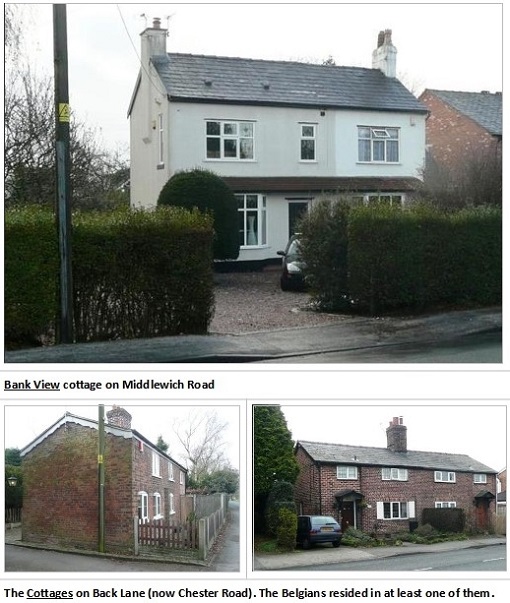 (2) The Victor Family - Mother and father, three children and two
grandparents, from Antwerp. They arrived in November 1914 and were
housed at Bank View on Middlewich Road. They moved to Oldham in May
1915 when Mr Victor found work “at his own trade”.
(2) The Victor Family - Mother and father, three children and two
grandparents, from Antwerp. They arrived in November 1914 and were
housed at Bank View on Middlewich Road. They moved to Oldham in May
1915 when Mr Victor found work “at his own trade”.
(3) The Gillyns Family - Mother and father (Antoine) with two children,
Germaine and Pierre, from Steenocherzeel. They arrived in November 1914
and were housed in Mr Massey’s cottage on what is now Chester Road.
They left in September 1915.
(4) The van Autro Family - Mother and father (Louis) with three
children, including Georges, from Antwerp. They arrived in December
1914 and were housed in the rooms above Bella Casa. They left in August
1915 and went to Paris to stay with relatives.
There could have been other families who stayed in Holmes Chapel, but as you can tell from the lack of forenames, the refugees did not make a lasting mark in the records and life of the village. Certainly, there were other families at Somerford Hall, Jodrell Hall and also around the area, supported privately by local well wishers. Despite the warm welcome, the refugees were keen to go home when the war ended. In March 1919 the Crewe Chronicle reported: “Belgians Depart. After a sojourn of over four years, the refugee Belgians and their families left for their native country taking advantage of free passage under the repatriation scheme.”
Considering the current Ukrainian crisis, the saying “To know your future you must know your past” couldn’t be more appropriate.
This article was published in "The Villages Mag" July 2022
Click here to return to top of page.Thomas Worthington Barlow
In the chancel of St Luke’s Church in Holmes Chapel, on either side of the altar, stand two imposing chairs, donated in the mid nineteenth century by Thomas Worthington Barlow in memory of his parents, William Worthington Barlow of Cranage and his wife Lucy, daughter of the long serving vicar Rev. Thomas Hodges of Lane Ends. William was a surgeon and landowner and two of Lucy’s brothers followed their father into the Church, though Thomas Worthington Barlow himself studied at Gray’s Inn and was called to the Bar in 1848. Practising law in Manchester, he had married young and was living in Cheadle with his wife and two young sons in 1851. Growing up in the village, he clearly loved his grandfather’s church and the local countryside, and it was these interests which led him to join two prestigious learned societies, to publish several books and to gain recognition as an antiquarian and naturalist. In 1847 he was elected a fellow of the Linnaean Society, still flourishing and dedicated to the study of natural history, and always used the letters FLS after his name. In the same year he published “A Chart of British Ornithology”, followed by “A Field Naturalist’s Notebook” the year after, and in 1852 “The Mystic Number: a Glance at the System of Nature”. At some point he was elected to the Wernerian Society of Edinburgh, which counted many illustrious scientists among its members, including Sir Joseph Banks the botanist, Friedrich Mohs the geologist, William Scoresby the Arctic explorer and James Watt the engineer.
He was also passionate about the county of his birth, as shown by a series of publications in the 1850s. First came “Cheshire, its Historical and Literary Associations” in 1852, followed by “The Lancashire and Cheshire Historical Collector” a periodical which lasted till 1855, then “A Sketch of the History of the Church at Holmes Chapel, Cheshire” in 1853. This book remains one of the key sources for any study of St Luke’s, and Thomas clearly had access to all of the records kept in the parish chest, some of which have since been lost. He also edited and reprinted the diary of Edward Burghall, the Puritan vicar of Acton, near Nantwich, from 1628 to 1663 and a “Memoir of William Broome”, an 18th century poet and translator from Greek, who was born at Haslington in 1689.
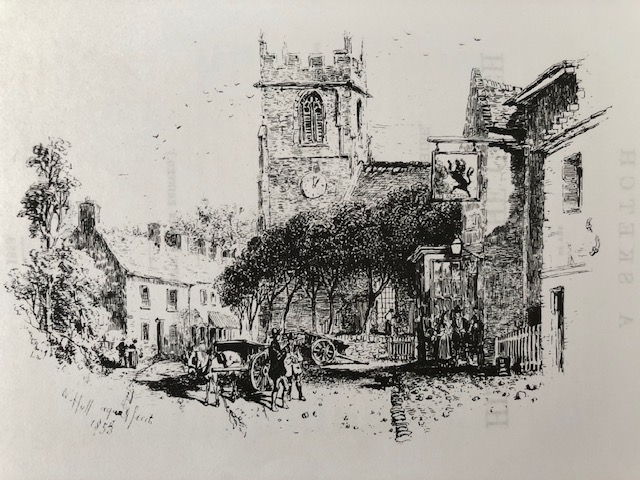
Clearly a hard working and scholarly man, he was surely destined to be more widely known and appreciated, but his life was a short one. His sketch of the church at Holmes Chapel was intended to be only the first step towards a more substantial history, which was never undertaken. In April 1856 he was appointed Queen’s Advocate for Sierra Leone, then a British colony in West Africa, where he became the chief legal officer. Tragically, he died aged 33 only four months after his arrival in Freetown, probably a victim of one of the many fevers which afflicted the district. His widow Anna (possibly Hannah) was described as “of independent means” in the census of 1861 and was raising their children in Stretford, Manchester. It is to be hoped that they were frequent visitors to Holmes Chapel, where their relatives were prominent landowners well into the 20th century.
This article was published in "The Villages Mag" August/September 2022
Click here to return to top of page.A Brief History of The Fire Service in Holmes Chapel
The logical place to begin this narrative is the Great Fire of Holmes Chapel which occurred on the morning of Tuesday, July 10th 1753. The fire, originating in a button maker’s shop,was sudden and severe, made all the worse because the majority of villagers had travelled to a meeting in Northwich, leaving very few left to fight the fire.
The first Fire Brigades were being formed around this time, but sadly not yet in Holmes Chapel. Nearby Congleton acquired its first appliance in 1765.The earliest fire-fighting arrangements were run by voluntary organisations, parishes or insurance companies.
The first mentions of a fire brigade in Holmes Chapel date from 1884 when the new Parish Magazine was published, but it had clearly been in existence prior to then. There are records relating to the Fire Brigade Accounts over several years in the 1890s. The costs of running the service were largely borne by the more affluent residents of the village through voluntary contributions, although charges were made on those residents who could afford to pay.The firemen were paid for their services and the annual running costs were around £60 a year in the 1890s. Fire emergencies were called by ringing the church bells.
There was much concern about water supplies in the village around this time. The pump was reported to need 40 buckets of water a minute to feed it and adequate supplies were often not available. Consideration was given to various options but it seems nothing came of these deliberations and it was not until piped water arrived in the village around 1910 that reliable supplies could be accessed, although this was still limited until supplies were improved in the mid-1930s.
The Fire Brigades Act of 1938 created Fire Services to be managed by Local Authorities, resulting in the Holmes Chapel volunteers being told their services were no longer required! WWII saw these arrangements suspended and replaced by a National Fire Service. New legislation in 1947 saw a consolidation of fire services into brigades covering geographical areas. Further legislation in 1974 and then in 1997 finally led to the creation of the current Cheshire Fire & Rescue Service.
Holmes Chapel’s original horse drawn fire pump was believed to have
been kept in a shed behind the Bulls Head pub at a cost of £2.50 a
year, with the horse stabled where Sutton Oaks is now. Later, the pump
was moved to Mr. Uriah Plant’s premises on Middlewich Road due to the
poor condition of the Bulls Head shed. The pump was subsequently housed
at Jubilee Garage on London Road. Following the acquisition of its
first motorised fire tender in the 1930s,the Fire Station was based in
premises at Sandiford Cottage (see photo).

The new Fire Station was opened in 1963 and has recently been upgraded. It now houses a Dennis Sabre appliance along with a Range Rover fast response vehicle – useful for the frequent accidents on the M6 motorway, which has long been the greatest demand on the local crew. Holmes Chapel is still operated by a team of 15 retained Fire Fighters who must live close by to provide the quick response necessary for callouts. The Fire Service is always keen to hear from prospective volunteers who meet the required criteria.
This article was published in "The Villages Mag" October 2022
Click here to return to top of page.Byley War Graves
Lest we forget...
Tucked away behind a local village church is a chill reminder of the Second World War. If you are interested in visiting, park in front of Byley Village Hall, and proceed into St. John the Evangelist’s churchyard. Then following the path towards the back of the church, in the corner you will find 18 Commonwealth War Graves dated from 1941 to 1946. These graves represent seven air crashes. A number of the 18 men buried here were from Australia, Canada and New Zealand. After the war it was considered too great a task to repatriate all the war dead from Commonwealth countries.
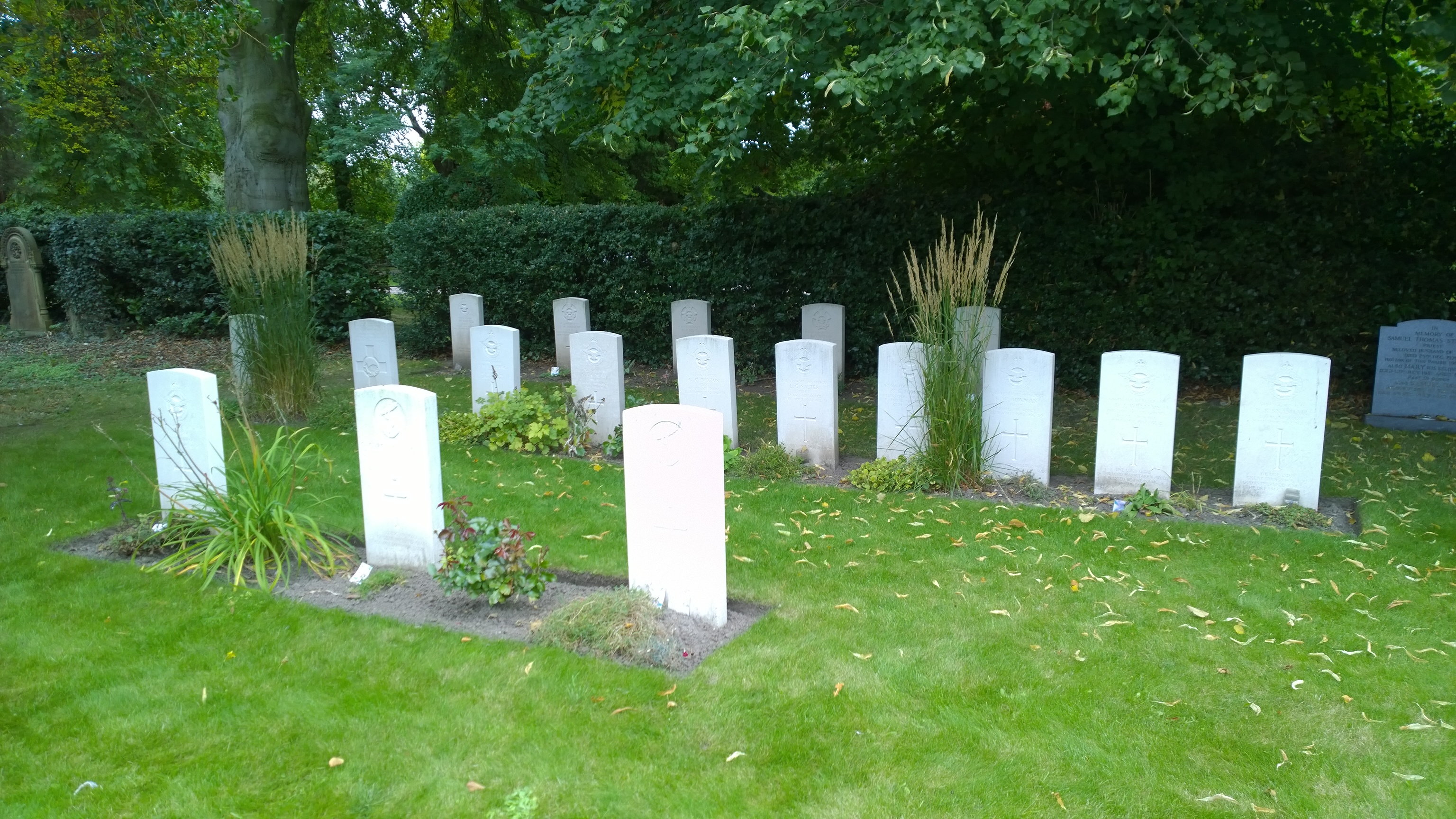
The worst occurred on 28th April 1942 when a Lockheed Hudson crashed into the ground near Drakelow Lane, Byley. It was making its approach to RAF Cranage airfield when it came down. Eight of the men killed were buried at Byley, and the ninth was returned to his home town for burial. No longer in existence, RAF Cranage was located behind Byley Primary School, running almost up to the Three Greyhounds pub, and across to the M6. Located there, were a School of Air Navigation and 96 Squadron tasked with the night defence of Liverpool and the North-West Midlands.
Buried in Byley churchyard are:- Sergeant Peter HILL, RAF VR (Volunteer Reserve), aged 20 and Flying Officer Eric PADFIELD, RAF, aged 22 who died on 21st March 1941 at Rednal, Oswestry, Shropshire. Three others also died and were buried in their home towns.
Sergeant Ivan ROBINSON Royal New Zealand Air Force, aged 20 who died on 22nd July 1941 at Eddisbury Hill, Delamere. One other died and was buried in his home town.
Those who were killed on 28th April 1942 were:- Flying Officer John BOTTING,RAF VR, Flight Sergeant Brian BOWMAN,RAF aged 25, Flying Officer George BUXTON,RAF VR aged 21, Flight Sergeant Charles FORREST, Warrant Officer Leonard SALTER, RAF aged 31, Flying Officer George SEALE, RAF VR, Corporal Reginald SNASHALL, RAF aged 22, Flight Sergeant David WILLIAMS, RAF aged 21, and one other who was buried in his home town.
Sergeant James MATHESON, Royal Canadian Air Force aged 22 and Sergeant Richard REAY, Royal Canadian Air Force aged 20 with two others who were buried in their home towns, died on 15th October 1942 when their plane crashed near Buxton.
Flight Sergeant William FORBES, Royal Australian Air Force aged 23 and Flight Sergeant Leonard WATSON, Royal Australian Air Force, together with six other airmen who were buried in their home towns, died on 20th March 1943 near the site of Leighton Hospital.
Aircraftman 2nd Class Paddy CLARKE, RAF VR aged 19, together with four others, died on 17th June 1943 when their plane crashed.
Petty Officer George REYNOLDS DSM, Royal Navy aged 24, and Commander Lawrence SHARMAN, Royal Navy aged 37, together with three others, died in a mid-air collision near Minshull Vernon, narrowly missing Wimboldsley Hall farmhouse, on 11th February 1946.
They shall grow not old, as we that are left grow old: age shall not weary them, nor the years condemn. At the going down of the sun and in the morning, we will remember them.
This article was published in "The Villages Mag" November 2022
Click here to return to top of page.Pantomine
During the dark days and nights of the midwinter festive season many families enjoy a visit to the theatre to see a traditional pantomime, and regard it as an essential part of the celebrations. In the Holmes Chapel of yesteryear, there was no need to leave the village as plays and concerts were often staged at the Victoria Hall (now the Vic Club) and at the Assembly Rooms on what is now Church Walk. No doubt the Amateur Dramatic Society included familiar pantomime tales in its repertoire, though no posters or programmes have hitherto come to light.

Nowadays loosely based on traditional children’s stories, pantomime began as an entertainment for adults, with its roots in the Roman midwinter festival of Saturnalia, when everything was turned upside down - men dressed as women and women as men, just like the Dame and Principal Boy, and fortunes were reversed, with masters becoming servants and servants masters, just like Cinderella finding her Prince and poor Jack making his fortune. This reversal was also to be found in medieval halls and castles where a Lord of Misrule (often a servant) was appointed to preside over the revels.
In the eighteenth century a dash of the Italian commedia dell’arte was added, with stock characters Harlequin and Columbine almost thwarted in their love by the villain Pantaloon until the inevitable dramatic twist, followed by much dancing and clowning to the delight of the audience. After that, fairy and folk stories and tales from the Arabian Nights gradually replaced these characters and a distinctive repertoire emerged – among them Cinderella, Puss in Boots, Jack and the Beanstalk, Little Red Riding Hood, Sleeping Beauty, the Snow Queen, Aladdin and Sinbad, which we all know and love.
One of the great things about pantomime is its flexibility. Within the familiar stories of hardship, disguise and misunderstanding and eventual rags to riches, there are countless opportunities for interludes of singing, dancing, jokes and audience involvement. In the days of the music hall, famous acts could weave in their own party pieces and today’s stars often choose the pantomime format for their Christmas TV specials, with some even returning to the theatre for the thrill of performing live.
It doesn’t look as though there will be actual pantomime on stage in Holmes Chapel this winter, but there are numerous other entertainments planned so do make sure to keep the Yuletide spirit by supporting them. Season’s greetings!
This article was published in "The Villages Mag" December 2022
Click here to return to top of page.Bridging the Dane
The River Dane is a mature river, with many meanders but also a powerful current which has turned the wheels of many mills in the past and which continues to generate power by means of an Archimedes Screw near Cranage Bridge. There has been a stone bridge at this location for at least 700 years and probably longer, for the “Great Road to the North” from London to Warrington and over the Mersey was an important military road and trade route for coaches, wagons and drovers. The road was eventually turnpiked, with traffic regulated and tolls collected at turnpike gates along the way, all now gone. The bridge was widened by Cheshire County Council in 1935 though care was taken to rebuild the existing masonry arch and stone parapets.
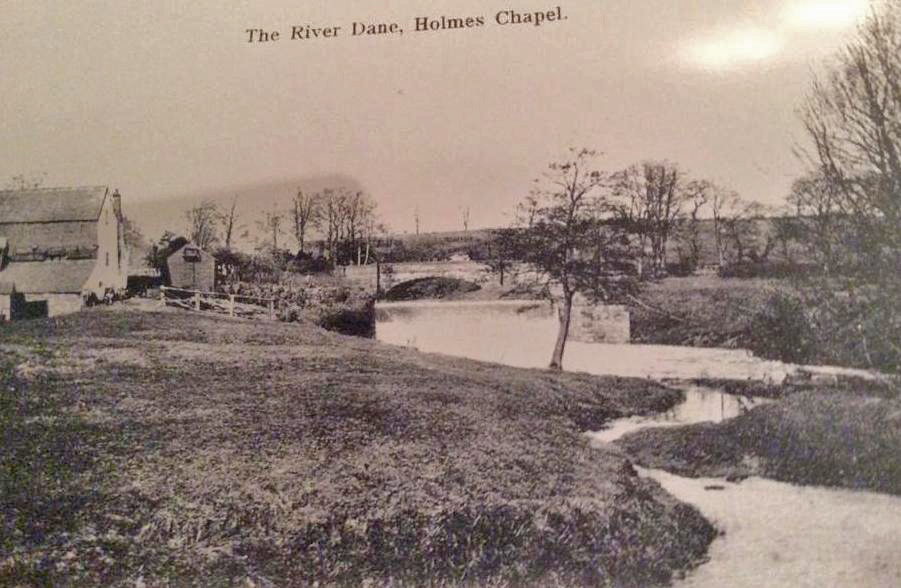
The next bridge upstream, to the east of Cranage, is Hermitage Bridge, dated 1707. Leading to the ancient mansion recently renamed Hermitage Hall, the bridge was built by a previous owner of the estate, Thomas Hall the ironmaster. He owned Cranage Mill and forge and gave generously to St Luke’s Church and other public works. The stone bridge no doubt replaced an earlier wooden structure.
Continuing eastwards, the Dane is next crossed by the magnificent brick railway viaduct, completed by the Manchester and Birmingham Railway Company in 1841. The broad, marshy valley presented a huge challenge to G.W.Buck, the Company Engineer and the contractors and navvies who built the 23 arches. The navvies lived in accommodation in the village of Holmes Chapel and in a temporary encampment at the foot of the viaduct during the two years of construction, as recorded in the Census of 1841.
Close by the viaduct is Saltersford Bridge, the name providing evidence of the importance of the old salters’ ways along which pack animals would carry precious loads of salt produced from the mid Cheshire brine pans to distant places where it was used in tanning and preserving food. There was a shallow ford at this point in Roman times, and the first record of a stone bridge dates from 1331. Bridge tolls were collected to cover the costs, and eventually the road to Chelford over the bridge was turnpiked. There is still an old toll house by the road on the north side of the river.
Downstream from Cranage Bridge, going west, the next bridge is the massive construction of the early 1960s which carries the M6 over the river. There was once another bridge about half way between the two called Sparrow Bill Bridge, part of the carriage drive to Cranage Hall from Middlewich Road. This was in regular use until 1929 when the hospital took over the Cranage Estate and it fell into disuse. There are a few indications of its existence still visible on old maps and on the ground, in the form of a footpath leading from Bramhall Drive to Dane Meadow.
This article was published in "The Villages Mag" January/February 2023
Click here to return to top of page.Samuel Swain
Number 1 Macclesfield Road now houses the Don Alberto Italian restaurant and looks like a period building, though it dates only from around 2002. Outwardly it looks very similar to the previous double fronted building on the site, which in Victorian times was owned and inhabited by Samuel Swain, a plumber, ironmonger, painter and decorator who, with his brother James, provided essential services when the village was much smaller (only 500 inhabitants) but more self-sufficient. Swain Bros occupied the shop on the left hand side and Sam’s wife Emma ran a haberdashery next door. After their time other businesses took over the premises – their daughter Kathleen sold women’s and baby clothes for many years and there were other dress shops, there was a pharmacy run by Mr Quinn and, later, a travel agent, a discount store, the Oasis cafe run by the Holmes Chapel churches and the office of Poole and Alcock, solicitors.
Shortly before its demolition, a box of old account and copy books from Swain Bros were found in the building and passed on for research and safe keeping by local historians. These have recently been passed on to our group and a decision had to be taken about their future as our group does not have suitable storage facilities. The seven books, though mostly legible, are very fragile due to age and are in need of professional conservation. Fortunately, the County Record Office at Chester has an interest in local business records (and the necessary expertise) and has accepted the Swain books into its collection for assessment, conservation and storage in appropriate conditions. Once catalogued they will be accessible for many years to come to anyone with an interest in this aspect of local history.
In some ways, the contents of the books are rather mundane, being the daily details of running an ordinary, everyday business, but the passage of time makes them valuable, particularly when cross referenced against other sources. So we can learn more about the local gentry, where they lived, and how much it cost to keep these grander houses in good repair as well as the lower expenditure of more modest households.Other customers included the parish church and local chapels as well as schools and local businesses, including Morreys which, of course, is still going strong. The letters reveal a varied business, from signwriting for the Red Lion (“Dinners, Teas and Billiards”) to supplying paint to village wheelwrights. A letter from James Swain to a relative reveals some competition between Swain Bros and the rival ironmonger Henshaws, who had rolls of wire netting on display outside their shop on The Square - James urged Uncle to send some more so they could do the same. The importance of rail transport is also evident from the letters, which often refer to goods having to be collected from the station. This delightful photograph shows the shop frontage with Samuel, James and an assistant proudly displaying their wares.

This article was published in "The Villages Mag" March 2023
Click here to return to top of page.Somerford Hall
Our local history article this month takes us out to Somerford, now a growing community between Holmes Chapel and Congleton. As you drive along the A54 road approaching Somerford, there is a long stone wall on the left. This is the boundary of Somerford Park and its one-time Hall, a grand Georgian building which was built for Peter Shakerley MP around 1720 and included a separate Chapel. The Shakerley family were wealthy landowners, living at Hulme Hall near Allostock, who wanted a more prestigious house and used the Park for that purpose. The house was altered several times over the following years, before finally being inherited by Sir Walter Shakerley in 1898.
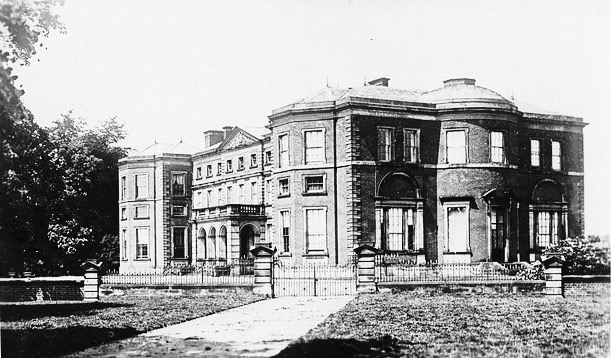
With demand for additional hospital accommodation in World War 1, Sir Walter offered Somerford Hall for use initially as a convalescent facility for wounded Belgian soldiers, cared for by members of the Holmes Chapel Red Cross. The site was redesignated an Auxiliary Hospital in early 1915 for British and Belgian soldiers. In December that year a further change had Somerford caring for some 40 typhoid fever patients, but by April 1916 the typhoid outbreak had diminished and following a rigorous disinfection, the hospital was expected to care for wounded soldiers once more.
Shortly after the outbreak of war, a Voluntary Aid Detachment (VAD) had been formed in Holmes Chapel which took over nursing duties at the Hall under the leadership of Mrs Reiss, the Commandant. The VAD had extensive support from the leading families of Holmes Chapel and District, Mrs Reiss being the wife of businessman Henry Reiss of The Hermitage. Subsequently, Sir Walter, who was now Honorary Colonel of the 7th Cheshire Battalion, took charge of operations at the Hall, assisted by his wife, Lady Hilda. The hospital continued in use until 1919, having looked after over 1400 patients. Following closure of the hospital the house reverted to being the Shakerley family home.
Holmes Chapel Parish Magazines from the time illustrate the voluntary community effort that was put in place to support the hospital during the war period. Many fundraising activities were held and gifts of local foodstuffs were made. This continuing fund-raising activity and the volunteer nursing and support effort was a tremendous achievement by the small local community.
Sir Walter had covered the costs of converting the Hall to a hospital, but due to both the costs of necessary refurbishment and recent ill health, Somerford Hall was sold in 1926 to a Brigadier-General Grenfell. Restoration proved uneconomic and the house was demolished in 1927, leaving some ancillary buildings and the Chapel as the main legacy. The parkland was acquired by Manchester City Council as a summer school and camp for 250 boys. It was later sold to Leeds City Council who continued this use. In 1959 Leeds proposed to sell the Park for use as an open prison, but considerable local protest saw the scheme killed off. It subsequently became an equestrian centre of some note, which continues today.
This article was published in "The Villages Mag" April 2023
Click here to return to top of page.May Queen Gweneth Haig
This is the story of Gweneth Haig who was Holmes Chapel May Queen in 1923, exactly one hundred years ago this May. After the death of her mother in 1910, when Gweneth Haig was born, she moved with her father, George Haig, to Holmes Chapel where he ran a grocers and confectionery shop. Kelly’s 1914 Business Directory lists George H Haig as a grocer in the premises on Macclesfield Road, now occupied by Mandeville’s Bakery. The 1921 census also tells us that George & Gweneth were still living at the shop, together with two maiden aunts Annie and Esther who had cared for her since she was a baby.
It was the same two aunts who in 1923 made Gweneth’s dress when she was chosen to be the May Queen for the Holmes Chapel May Day celebrations. Over this dress Gweneth wore a long trained cape, which on this occasion the aunts enhanced by adding a border of imitation fur. A newspaper report on the Festival described the Queen’s dress as follows: “Miss Gwen Haig wore a pretty dress of brocaded silk, her crown was of blue and silver tissue, and her train was trimmed with ermine.” There were six children in her retinue.

“The procession was formed near the Macclesfield Road School (today St Margaret Ward’s R.C. Church), and along the drive of the Hermitage. Horses and lorries were neatly decorated and carried the tiny tots, while older children dressed as characters walked besides them. There were two bands in attendance, plus the Training School Cadets from Saltersford College. Other groups involved were the ‘Morris Dancers’ and the ‘Military Maids’. Britannia & John Bull were well represented and the fairy queen and her maids provided a pretty setting.”
“Many hundreds of people lined the route down Middlewich Road and Back Lane (now renamed Chester Road), with many flags, bunting and garlands decorating The Square (the area outside Barclays Bank and St Luke’s today). Following the procession, there was a tea party in a marquee for over 200 children followed by maypole dancing; and Collins’ Fair provided further entertainment into the evening. The money that was collected (£8 10sh 11d) went to local charities, including the Winsford Infirmary.”
In later years, Gweneth became a ballet dancer and ran a ballet and dancing school. She partnered the famous Edouardo Espinosa when he came to Manchester. Espinosa was a British ballet dancer and teacher who was a co-founder of the Royal Academy of Dancing and established the British Ballet Organisation. Following her father’s death at the age of 59 in 1932, Gweneth married Crofton Granville Frost, a cotton goods salesman and buyer, in 1936 at Manchester, and they spent a short time there before emigrating to South Africa. They sailed from Southampton on 17th June 1938 on board the “Athlone Castle”.
However by 1939 and the start of the Second World War, they had returned to England and were living on Bolshaw Road, Handforth. Gweneth went on to drive ambulances during the war. She lived in Wilmslow from 1946/7 until her death at 88 in March 1999 following her husband’s death in 1996. If you would like to see Gweneth’s dress, it is currently on display in Congleton Museum.
This article was published in "The Villages Mag" May 2023
Click here to return to top of page.Holmes Chapel Census 1921
A census has been taken in England almost every ten years since 1841 and these are released for historians to examine after storage for 100 years. A few months ago the u3a Local History Group obtained the 1921 census results for the Parish of Holmes Chapel and Cotton. Each property completed a form on Sunday 24th April 1921 listing all the people in residence with their ages, marital status, what their occupation was and where they worked. The full analysis is going to take some time and members are just beginning to discover the story of the village in 1921.
We can answer questions about how the village has changed since the previous census in 1911 which was before the First World War. Had the population increased? Had WW1 affected the balance of men and women in the village? What had happened to the many men who went to war and survived? Some of these questions will take a while to research but already interesting information is beginning to emerge.
We now know the population of the village increased from 906 in 1911 to 991 in 1921. There were 51% male and 49% female in 1911 but in 1921 there were 47% male and 53% female. Could this be a consequence of the war or just a natural variation? There is more work to do on this.
We can find out what the popular Christian names were in 1921 in the village. For the men John and Thomas top the list and for the ladies, Mary and Ann. Amongst the unusual names were Horatio, Uriah and Eli for the men and Olive, Esther and Agnes for the ladies.
Another interesting area to explore is the world of employment. In 1911 the village was dominated by farming although the railway line was bringing some work and there were quite a few involved in house building. By 1921 the opening of the Holmes Chapel Wallpaper Works had created new opportunities for employment and of the 382 Holmes Chapel people employed, nearly 25% were working at Victoria Mills. Others were working for Brunner Mond at Middlewich and Northwich and 16 were employed by the railway company.
We can also look at how settled the population was by comparing who was living in the village in 1911 and still here in 1921. This is only a rough guide as we will not spot women who have married and still living in the village. However, we find 376, or 41% are still in the village and there have been 194 children born over the ten years. It is known that quite a few families moved to the village from Manchester to work at the wallpaper factory which helps to explain the increased population.
The history group will be using other sources of information to explore in more detail some of these topics in order to build up a picture of life in Holmes Chapel during the 1920s. If you are interested in being involved and learning more about researching our history take a look at holmeschapelhistory.co.uk
This article was published in "The Villages Mag" June 2023
Click here to return to top of page.Arclid Workhouse
In the past when people became poor and had no home or lost their job, they generally ended up in the workhouse. People would live and work in the workhouse in order to stay there, to have a roof over their heads. Once an individual had been admitted, they would be given a uniform to be worn for the entirety of their stay. The inmates were prohibited from talking to one another and were expected to work long hours doing manual labour such as cleaning, cooking or using machinery. Men had to chop wood, break stones or work in the fields. Women’s jobs were scrubbing walls and floors, washing laundry, sewing or weaving. It was a hard life! As well as the poor, orphaned children, the sick, disabled, elderly and unmarried mothers were also usually sent there. The local workhouse for Holmes Chapel was at Arclid, just south of Brereton. It was designed by Henry Bowman and built in 1844-5 at a cost of £7,097. It was intended to eventually accommodate 370 inmates.
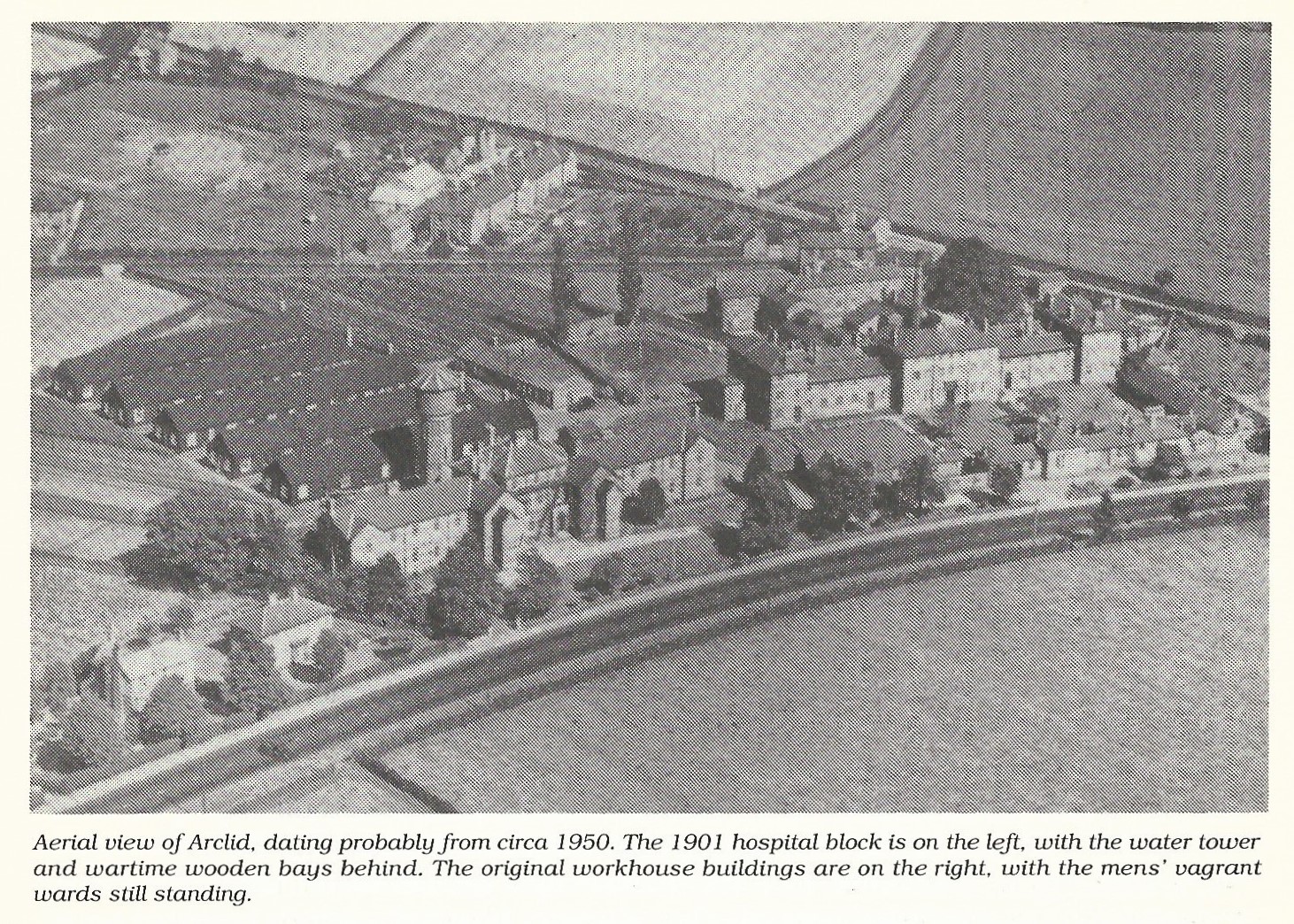
It comprised three main sections: an entrance block containing porter’s lodge and board room, a long main block of two and three storeys, and a two storey infirmary to the rear. The central section of the main block contained a dining hall at the front with the kitchens and laundry to its rear. To each side of the dining hall were school rooms, for girls at the north and boys at the south. In 1847, increasing concern at the lack of separate accommodation for fever cases led to the creation of a separate fever ward. This was achieved by the modest expenditure of £85 on roofing over two washhouses in the girls’ yard.
The original infirmary block had 26 beds, 13 for men and 13 for women. It was extended in 1860, and again in 1873 to increase the capacity to 58. However this still proved insufficient to meet the growing demands and in 1899-1900 a new infirmary was erected at the north of the workhouse. Designed by Alfred Price, it had 100 beds and accommodation for nurses. The total cost was £6,000 - £4,650 for the building, £1,250 for the boiler room, and £400 for furnishing the building.
During the First World War, 40 beds were given over for the care of military casualties. In addition, 20 paupers were taken in from the Wirral Union workhouse which was also being used as a military hospital. In September 1918 the casual ward in Congleton which had been closed the previous year was used to accommodate 10 German Prisoners of War who were employed in agricultural work in the area.
Later on during the 1920s the use of the infirmary as a general and maternity hospital gradually increased. Then, with the abolition of the workhouse system in 1930, it became officially known as Congleton Public Assistance Institution. During the 1930s the hospital became used for geriatric care and took on the name Arclid Hospital. It was here in 1941 that most of the casualties were taken for treatment after the overnight train crash in Holmes Chapel station occurred.
Arclid Hospital closed in the spring of 1993, and the buildings were demolished. Today it has been replaced by a new housing estate.
This article was published in "The Villages Mag" July 2023
Click here to return to top of page.The Swan Inn Cranage
Where in the Holmes Chapel area was the original Swan Inn? Today it is situated on the Congleton road next to the Railway Station, but over 200 years ago, it stood on Knutsford Road opposite Cranage Hall. Today the sign on the building simply says Swan Farm.

In those days, the Swan Inn would have catered for travellers of simple needs, such as pack horse teams and drovers rather than those going by stagecoach. Those travellers would probably have stopped off at the Red Lion in Holmes Chapel where horses could be changed for the onward journey.
The Swan Inn existed in the eighteenth century and there are records of refurbishment to the buildings between 1795 and 1797 by the then owner Richard Hall, when the roof was changed from thatch to slate and the barn repaired – all for about £100. Through the decades of the nineteenth century there are newspaper reports describing various events held at the Swan Inn, Cranage. Among them was a coroner’s court held there in April 1869 by the coroner Mr Dunstan. It was concerning the suicide of George Smith, aged only 24, a gamekeeper employed at Cranage Hall. Other newspaper reports tell of the Swan Inn being used regularly for auctions. In January 1871, a timber sale took place, where trees from a number of local farms were auctioned off in lots. Of note, was the large variety of trees for sale in Cranage and Holmes Chapel at that time – oak, ash, chestnut, poplar, elm, alder, sycamore, lime, fir and willow.
The Swan Inn was also regularly used to auction land and farm buildings in the area. In 1830, the following were for sale: the corn mill, a warehouse, the weir on the river Dane, various cottages and also interestingly a silk factory which had been lately erected and described as being three stories high with a constant and plentiful supply of water from the river. It was capable of containing nearly 500 dozen silk spindles. These buildings were all on the site of the present day Masseys by Cranage Bridge.
By 1851 the Swan Inn was tenanted by Thomas Clowes, who not only farmed 8 acres, but was also a wheelwright and a publican. By 1861, the Inn was being run by Peter Mee who was also a cattle dealer and a farmer of 9 acres. He lived with his wife Hannah, their house servant and on census night a cattle drover (a major occupation along this route). A second family appears to have occupied part of the Inn at this time and as it was a separate census record the building may have been split to form an independent household. In 1871, the innkeeper was absent, but his wife Mary Williams was present living with a grandson. By 1881, William Rosson, a farmer of 43 acres, lived there with his wife, seven children, a niece and a general servant.
The Swan Inn had remained in existence until the late nineteenth century when it then reverted to a farm, presumably when the droving trade declined as a result of the railways and the name was transferred to the new Swan Inn by Holmes Chapel station.
This article was published in "The Villages Mag" August 2023
Click here to return to top of page.Holmes Chapel Village Pubs
The recent reopening of the Swan Inn next to the station has prompted an interest in the old pubs of the village. The Swan was built at the same time as the railway station when the line opened in 1841. The land to the rear was used as pens for cattle awaiting transport by train to market and there is still a drainage grid which hints at this former use. Originally two separate buildings, the frontage was much changed by the replacement of the original level crossing with a bridge and embankment and the addition of a connection between the upper storeys. Refreshments and accommodation for travellers were provided from the start and there was a horse omnibus service to Congleton Station which was on another line.
The oldest pub and former coaching inn is the Red Lion, a major stop on the old route from Carlisle to London. Dating from at least the 17th century, the inn could accommodate about 30 guests in rooms of varying quality and many horses in stables fronting the main road and to the rear. The opening of new road routes and the railway affected stagecoach traffic, though there was a revival of business from private motorists and cyclists in the interwar years and it was possible to stay overnight until the 1970s.
Holmes Chapel is situated on an important East-West route, which explains the siting of two other pubs on either side of the crossroads. The original George and Dragon, also an old coaching inn, was destroyed in the Great Fire of July 1753 but quickly rebuilt to take advantage of demand for accommodation and stabling. Increased motor traffic and the need to widen the road led to its demolition in the late 1960s, though it was replaced at the same time by a new building set slightly further back.
On the other corner, now a flower bed and seating area next to the Italian restaurant, stood a third old coaching inn, The Bull’s Head. It overlooked the Square and was a centre of village life, with a butcher’s shop housed in a single storey annexe which projected into the Knutsford road, possibly built as a lookout for turnpike traffic approaching from the North. It also offered accommodation and stabling for many travellers and their horses well into the twentieth century, though it too was demolished for a road widening scheme in 1948.
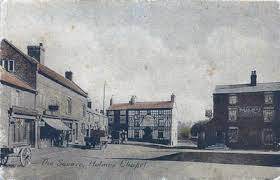
Demolition was the fate of another less ancient hostelry, The Good Companions. This was an hotel built by Wilsons Brewery in 1937, aimed at guests with motor cars and the means to enjoy short breaks in the countryside. It ended its days as a Berni Inn and the site is now occupied by Lovell Court. Another, now demolished, similar business was the Holly Lodge Hotel, which stood where Bernard Court is today. This was a private house until the 1970s when it was converted into a restaurant, bar and accommodation.
Thus it can be seen that the village has been well supplied with licensed premises over the centuries, and no mention has been made here of other venues such as the Victoria Club or the Community Centre, both of which warrant articles of their own in the future.
This article was published in "The Villages Mag" August 2023
Click here to return to top of page.Frederick Baden Benger
For many years, one of the major employers in Holmes Chapel was Benger’s Foods, housed in an imposing Art Deco “daylight” factory on London Road, just south of the railway bridge. Sadly, recent attempts to save the building from demolition came to nothing and the site is still unoccupied and up for sale. The main product was a very popular food supplement known simply as “Benger’s” and named after the founder of the company.

Frederick Baden Benger is believed to have been born in 1840 near Cirencester, Gloucestershire. By the age of 21, he was a chemist's assistant in London. He moved to Cheltenham, where he married Sophia Smith in 1866 and then moved to Salford, settling in Chorlton-cum-Hardy in the late 1860s. He met his business partner Standen Paine when they were both working as pharmacists for Mottershead and Company of Market Street, Manchester and in 1870 they bought the business and were looking for further opportunities. Benger’s work as Assistant Pharmacist at the Manchester Infirmary led to an interest in nutritional foods and he developed the formula for the milk based supplement enriched with vitamins and minerals which was to aid the recovery of numerous convalescents and make his fortune. It seems to have included enzymes which made it easier to digest and was served as a “food cream... with a delicate biscuit flavour” which could be adapted to suit the needs of the patient. The recipe was a closely guarded secret (and still is, according to many local people).Bulk manufacturing only started in 1891 when the firm was incorporated as a limited company, still based in Manchester. Benger eventually moved to Knutsford and lived at “The Grange”, a large Victorian house off the Chelford Road. He died in 1903 and is buried in Knutsford Cemetery on Tabley Road, where there is an elaborate memorial, now in poor repair. He left £420,000 in his will, some of it used to fund new laboratories in his name at Manchester University.
Despite the relatively expensive cost of 2 shillings and sixpence per tin, the company continued to prosper and Benger’s became a household name. It was even used for force feeding suffragettes on hunger strike in prison! New products were developed in the 1920s and the decision was taken to move out of the city to the clean air and rural surroundings of Holmes Chapel. The move was completed by 1938 and by 1947, when Benger’s became part of the Fisons Group, there were 350 employees. However, Fisons were less interested in promoting this particular product and by the 1960s it was no longer advertised and fell out of use. Maybe it is time for a comeback, given the modern interest in health foods?
This article was published in "The Villages Mag" September 2023
Click here to return to top of page.Christmas Greenery
 The
evergreen Christmas tree is a central part of the Christmas
celebrations, and decorated trees are everywhere - in public spaces,
churches and homes. This custom was introduced to Britain by Prince
Albert, husband of Queen Victoria, from his German homeland, but its
origins there are much earlier. Saint Boniface, an 8th century
Christian missionary, saved a child from pagan sacrifice on an oak tree
by chopping down the tree. The fir which sprang up in its place was
symbolic of the Christian faith and came to be associated with Christ’s
birth. The German religious reformer Martin Luther was said to have put
candles on a fir tree at Christmas to represent Heaven lit by
starlight, and by the early 17th century there were reports of trees in
Strasbourg being decorated with coloured paper, foil, sweets and fruit.
All of these are reasons for good cheer and the fragrance is a reminder
that nature will spring into fresh life before too long.
The
evergreen Christmas tree is a central part of the Christmas
celebrations, and decorated trees are everywhere - in public spaces,
churches and homes. This custom was introduced to Britain by Prince
Albert, husband of Queen Victoria, from his German homeland, but its
origins there are much earlier. Saint Boniface, an 8th century
Christian missionary, saved a child from pagan sacrifice on an oak tree
by chopping down the tree. The fir which sprang up in its place was
symbolic of the Christian faith and came to be associated with Christ’s
birth. The German religious reformer Martin Luther was said to have put
candles on a fir tree at Christmas to represent Heaven lit by
starlight, and by the early 17th century there were reports of trees in
Strasbourg being decorated with coloured paper, foil, sweets and fruit.
All of these are reasons for good cheer and the fragrance is a reminder
that nature will spring into fresh life before too long.
Other evergreens, venerated in pagan times at winter festivals such as the Roman Saturnalia, were adopted by Christianity but with more appropriate meanings. For example holly, with its sharp leaves and red berries, represents the crown of thorns worn by Jesus during His crucifixion, and the red berries His blood. Some old churchyards (but not, alas, Holmes Chapel) have the thorn tree Crataegus monogyna growing within the walls. This is the Glastonbury Thorn, which is said to have sprouted from the staff of Joseph of Arimathaea (who provided the tomb for the body of Christ) when he came to England and which continues to flower on Christmas Day, a sign of new hope. Some examples are certainly very old, and may be cuttings from the original in Somerset.
Holly, ivy, bay, fir branches and pine cones are used to deck the halls, but there is one evergreen which is never used in churches because of its use in the pagan ceremonies of the Druids, This is, of course, mistletoe, which they used in rites of human sacrifice and fertility. The custom of kissing underneath the mistletoe is probably a survivor of the latter.
More wholesome is the practice of wassailing apple trees at New Year. This involved rituals to encourage the trees to crop well in the following year. Customs varied around the country, but most involved songs, processions and drinking cider from large bowls decorated with ribbons and greenery. The greeting “Wassail!” is an Anglo-Saxon toast meaning “Be whole!”, and the correct response is “Drink Hail!”, meaning “Good health!”. May we wish the same to everyone who reads this article during this festive season.
This article was published in "The Villages Mag" December 2023
Click here to return to top of page.
